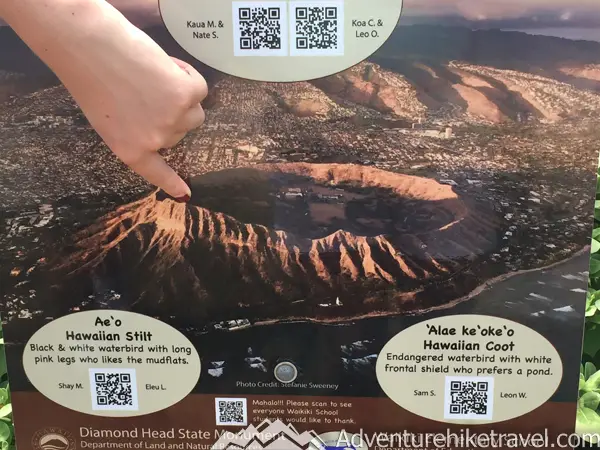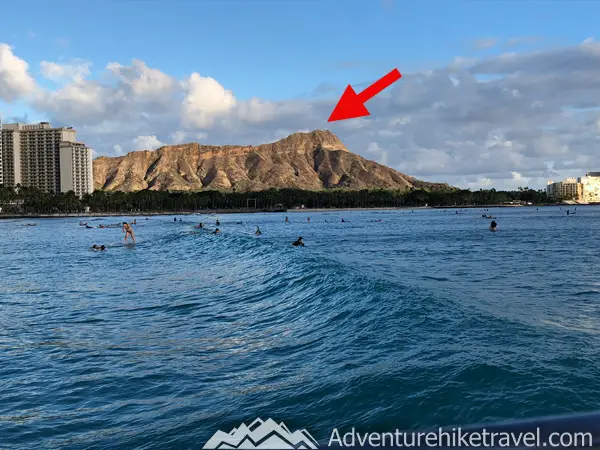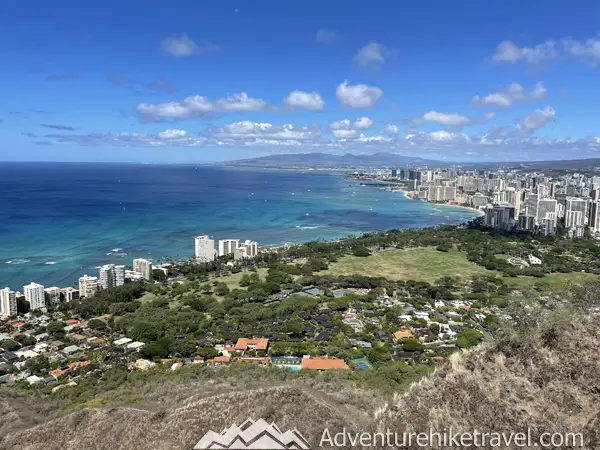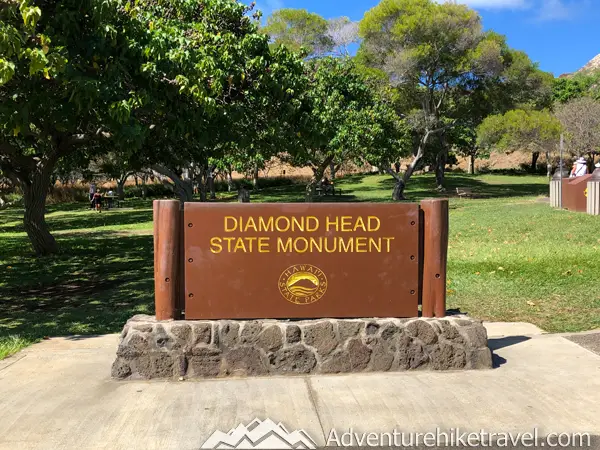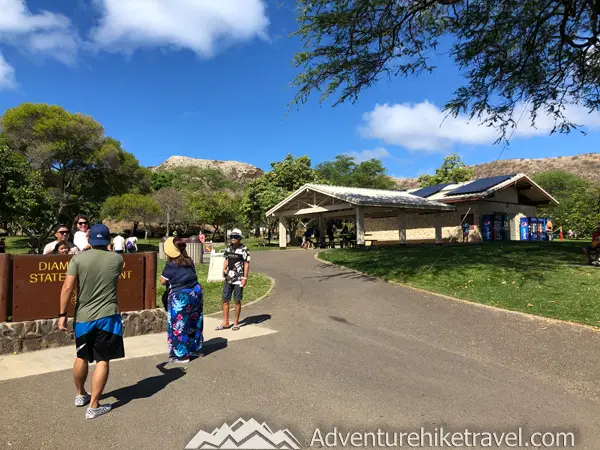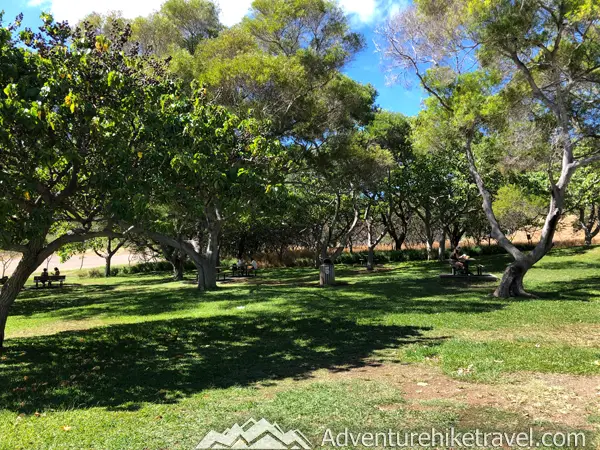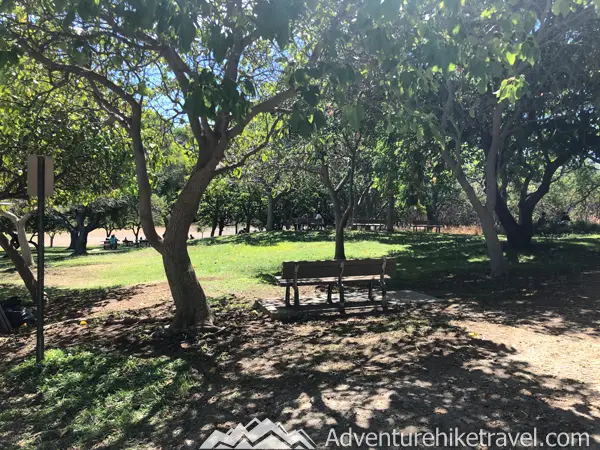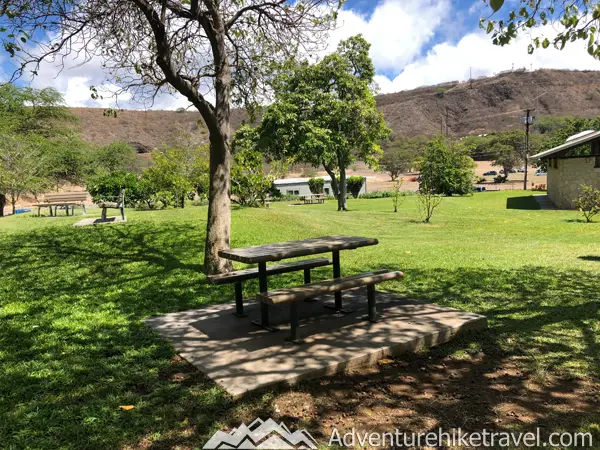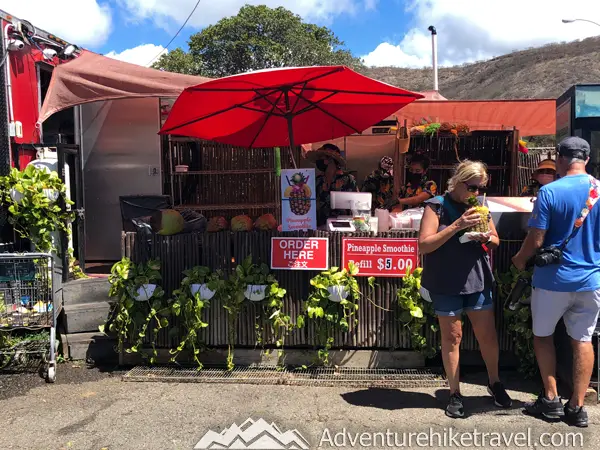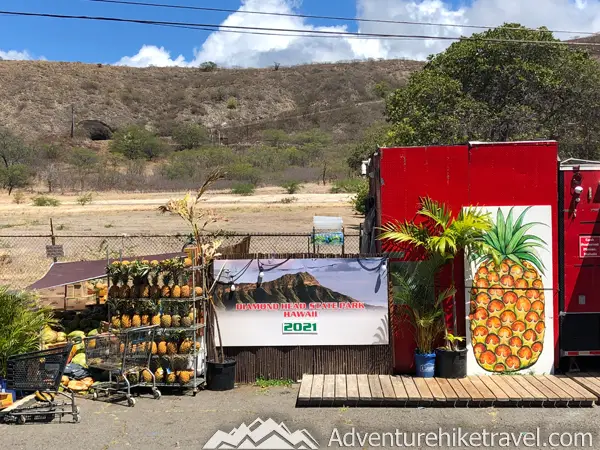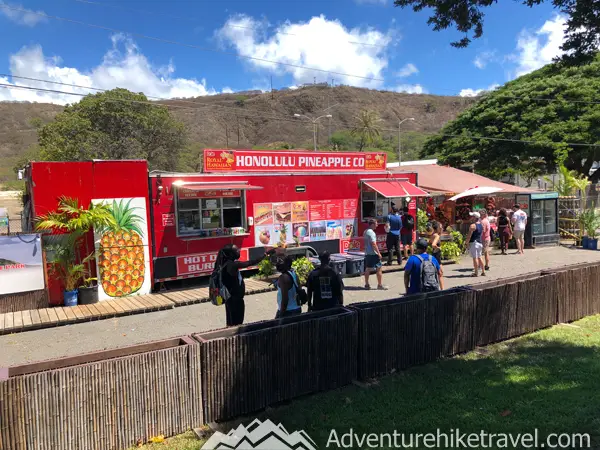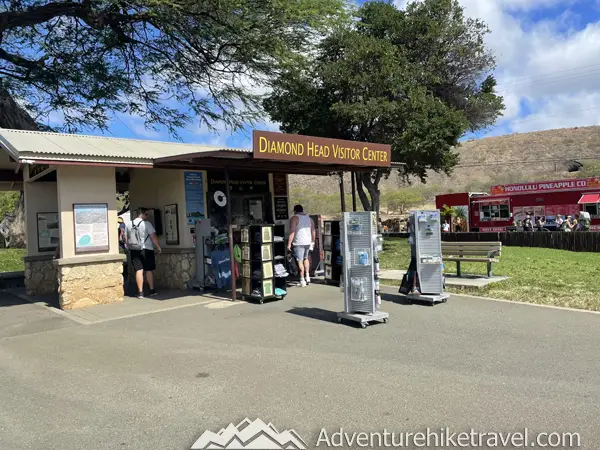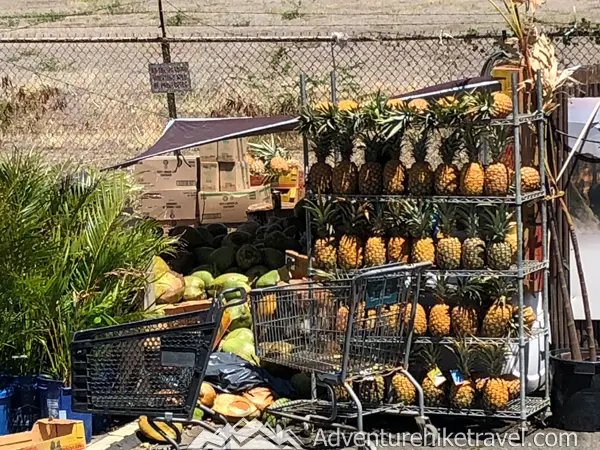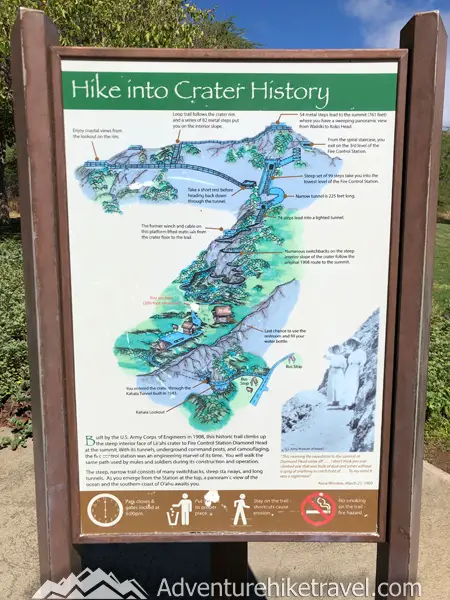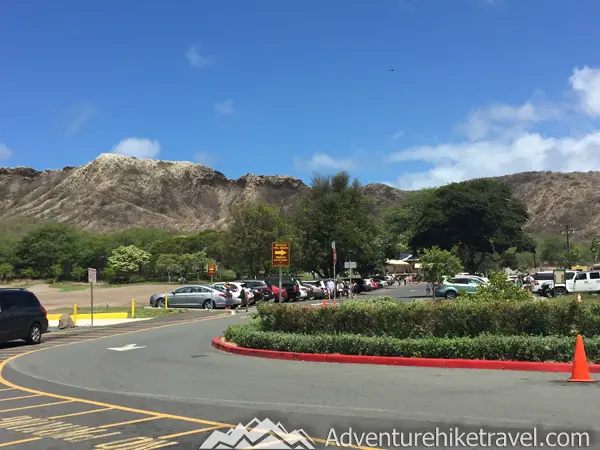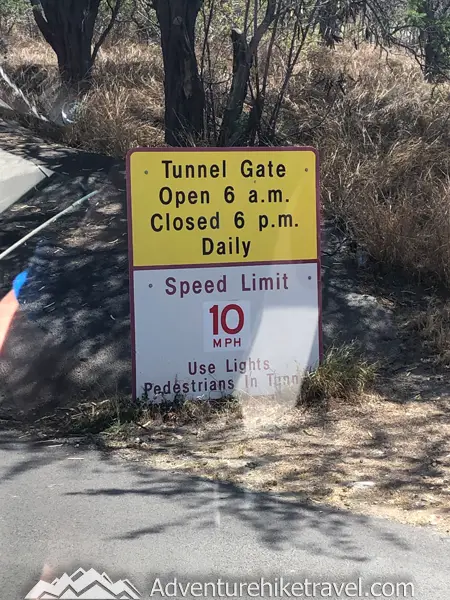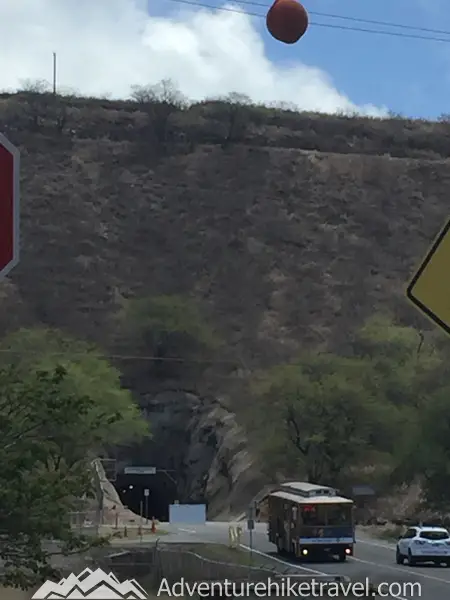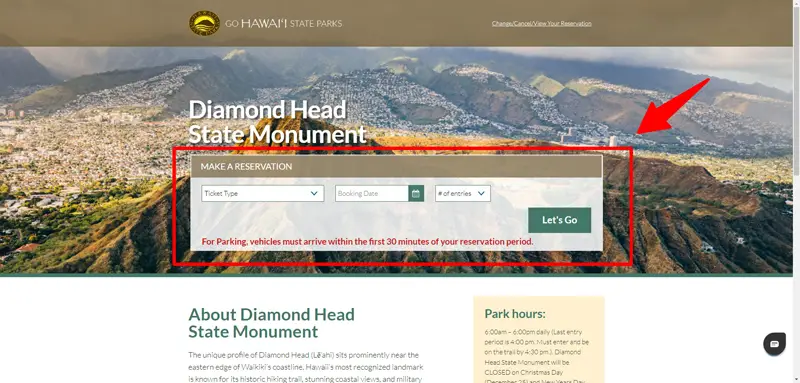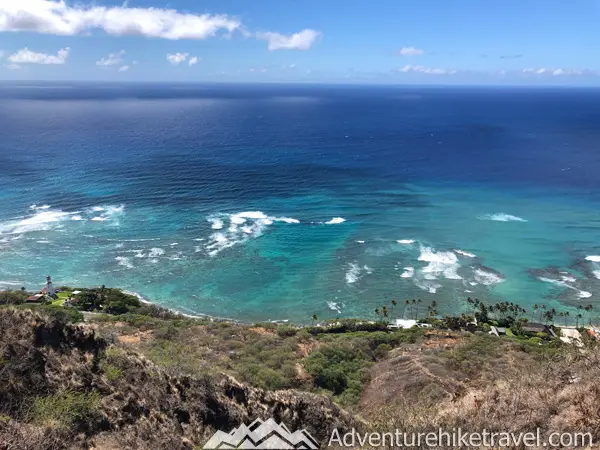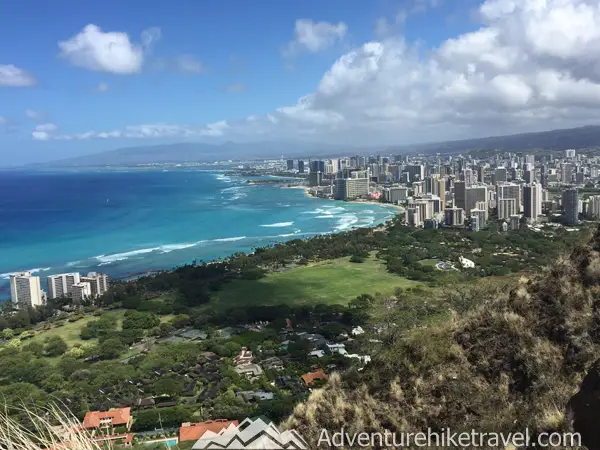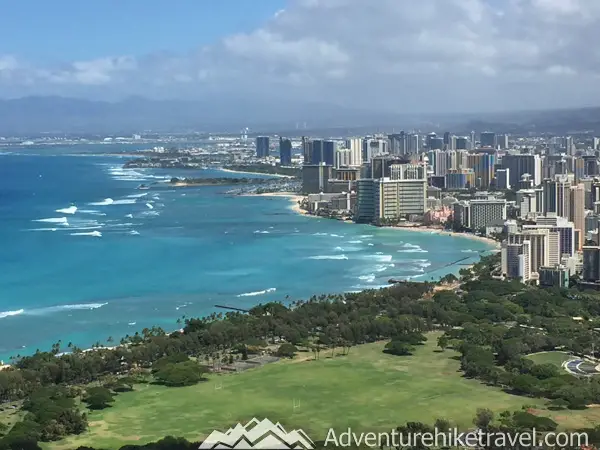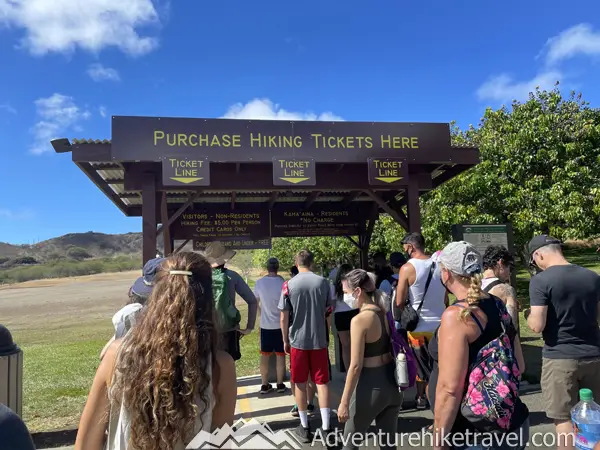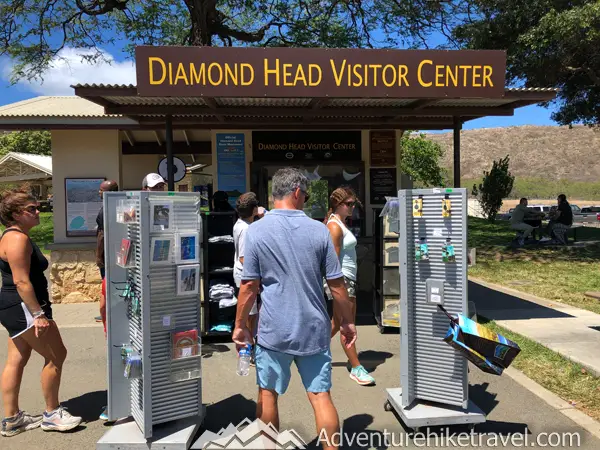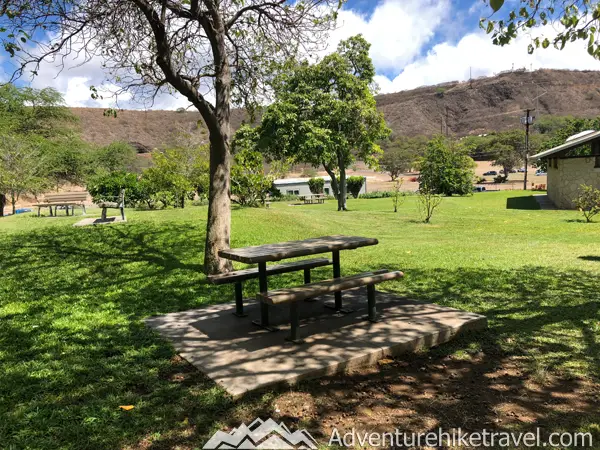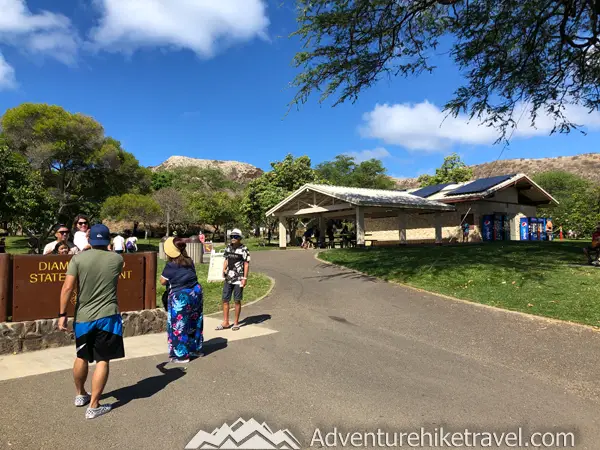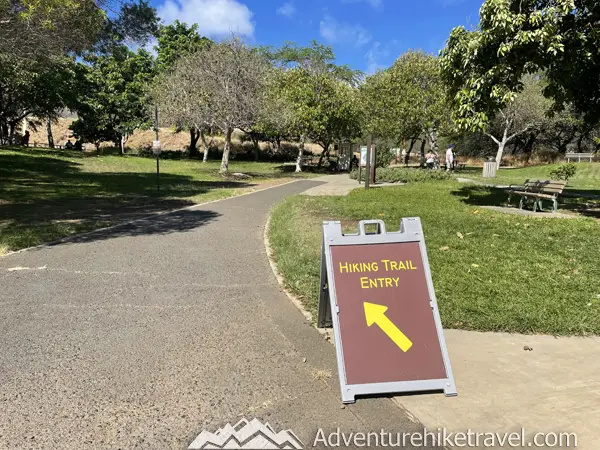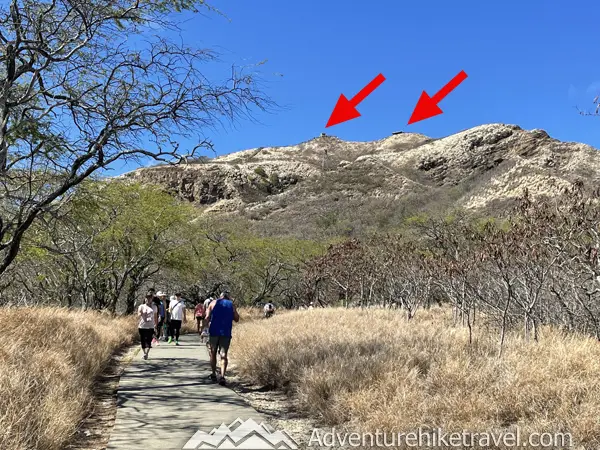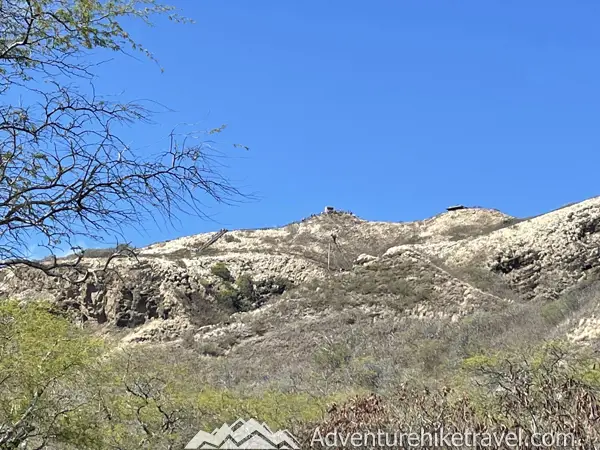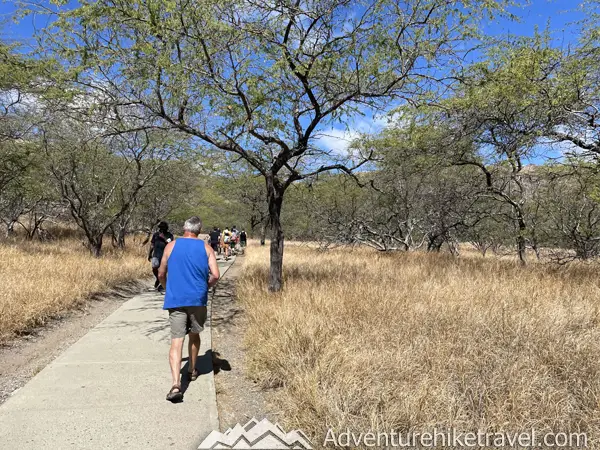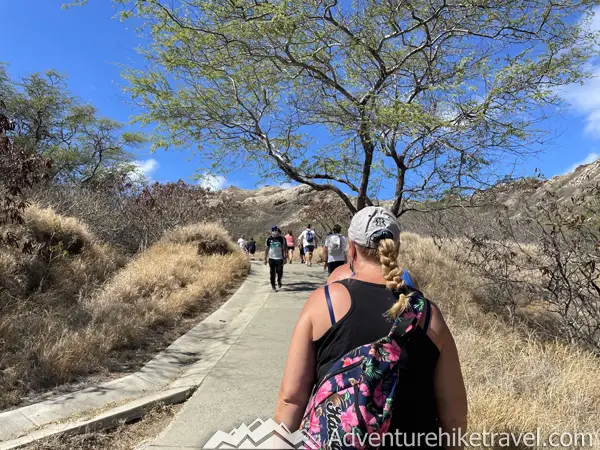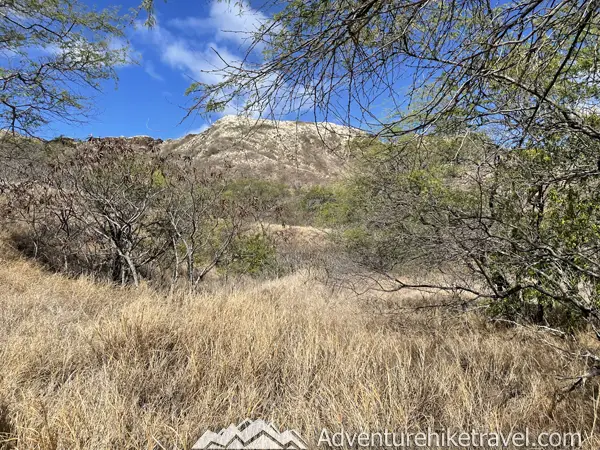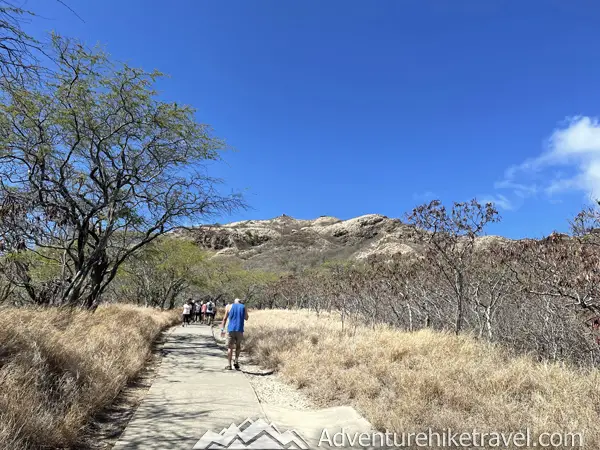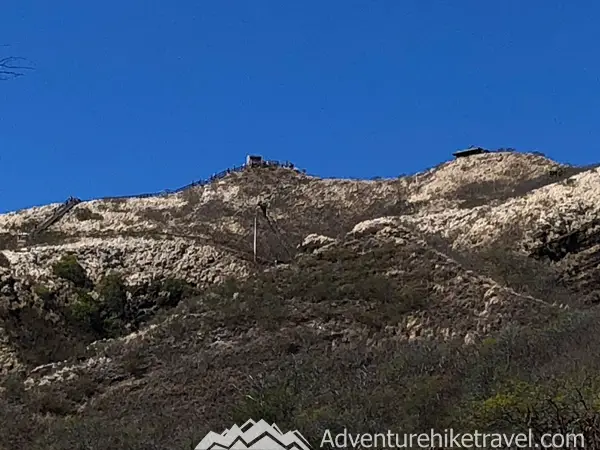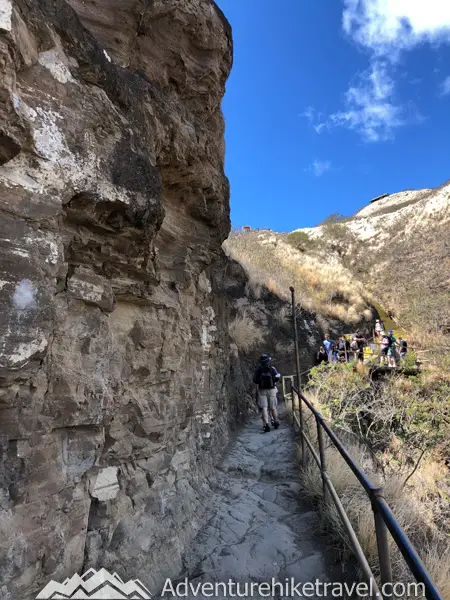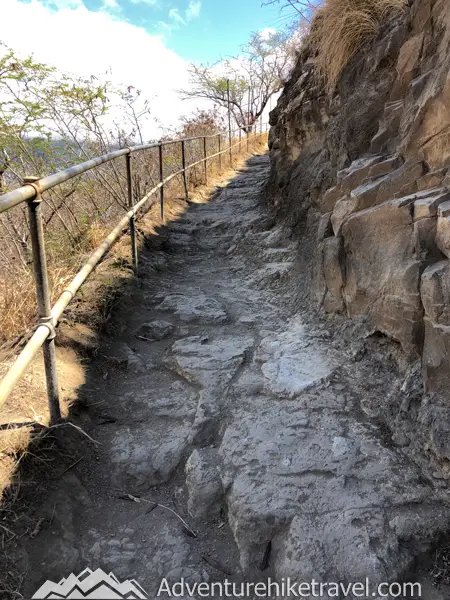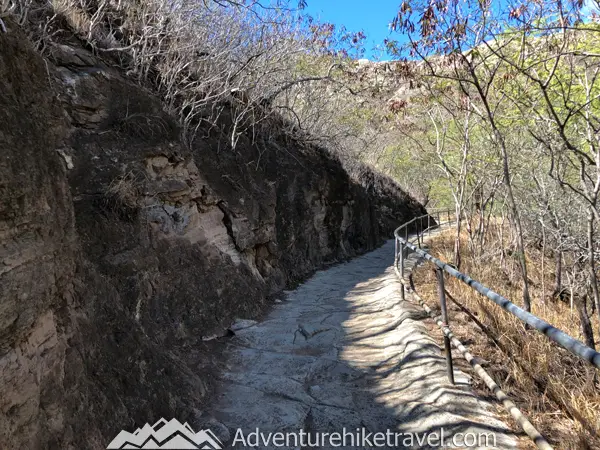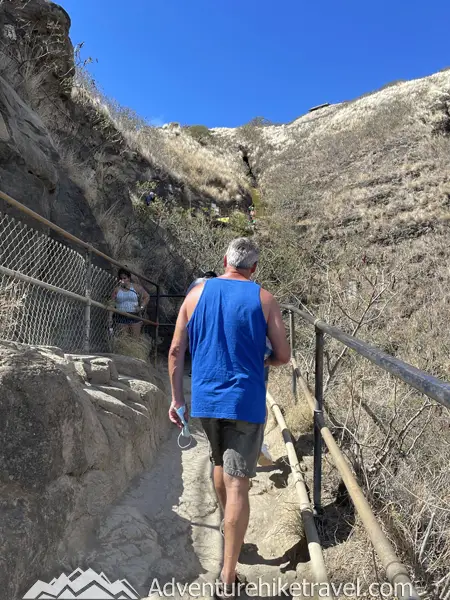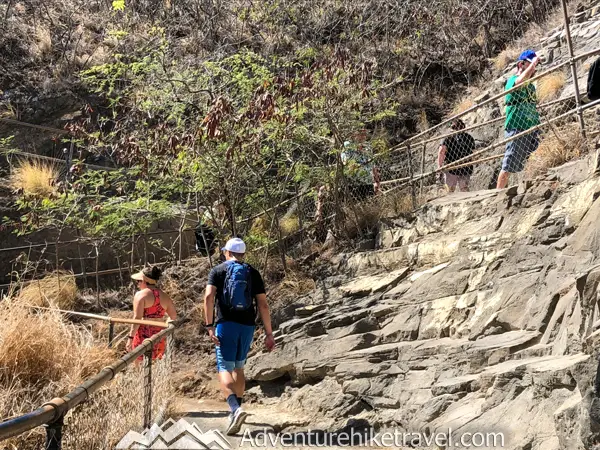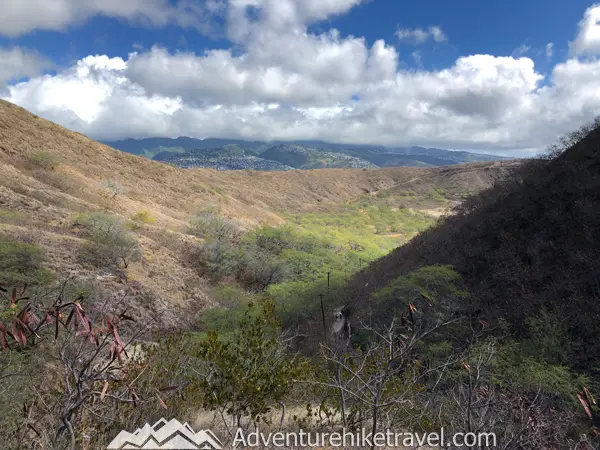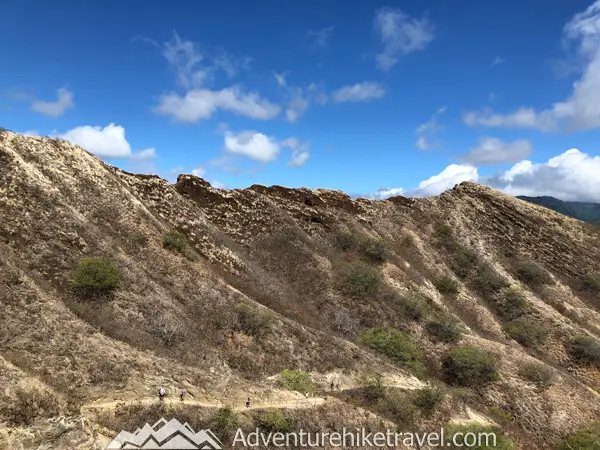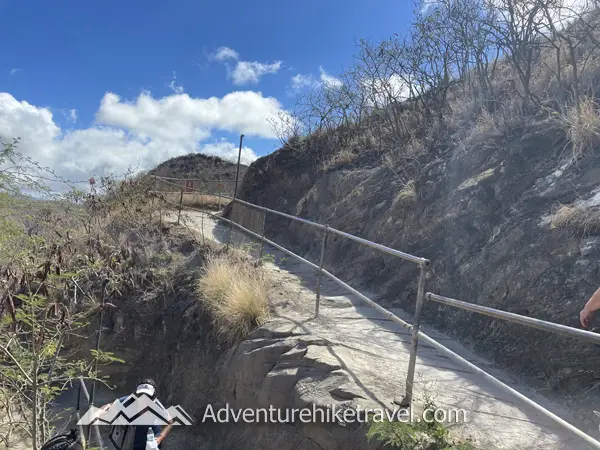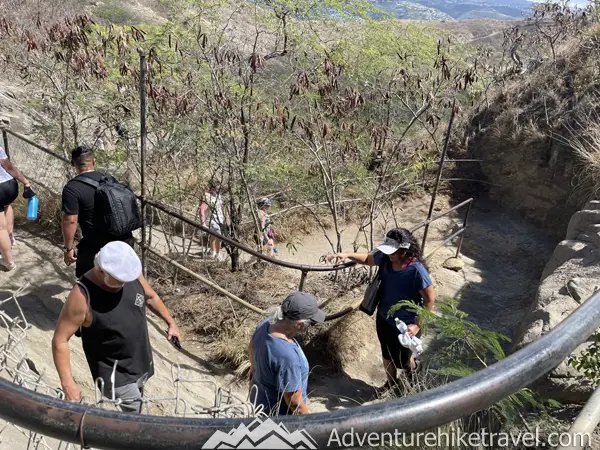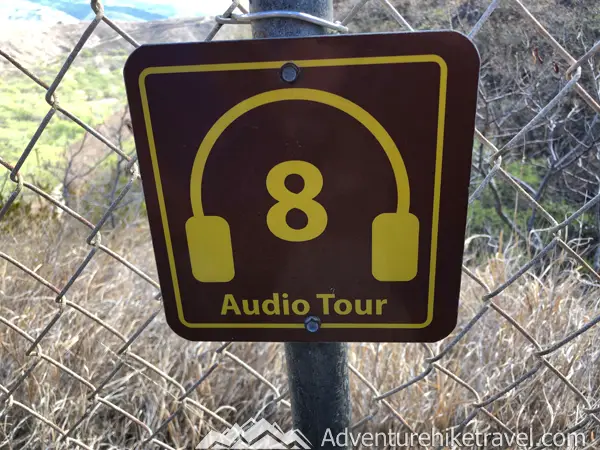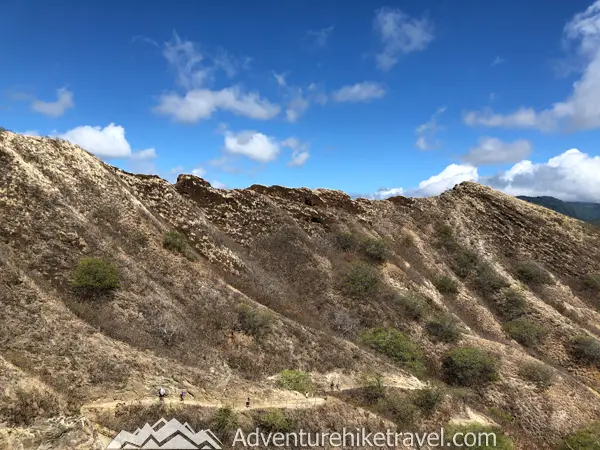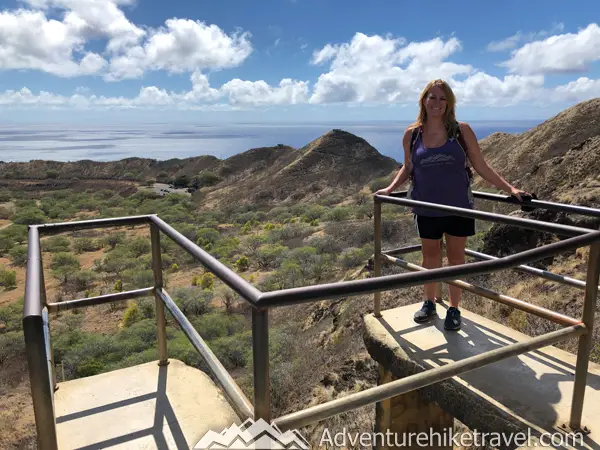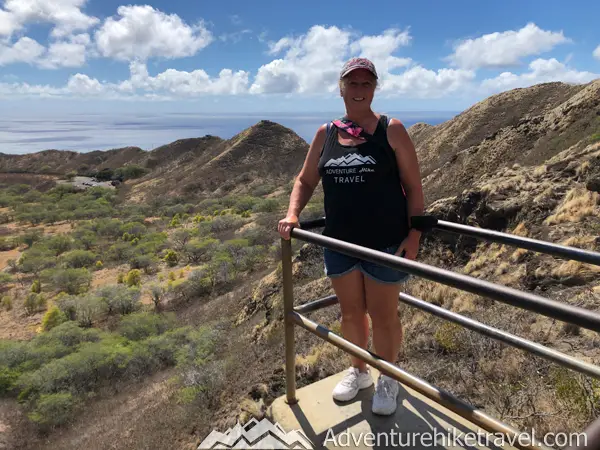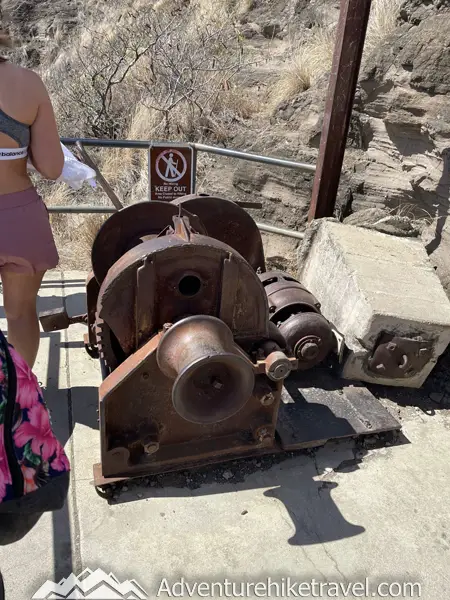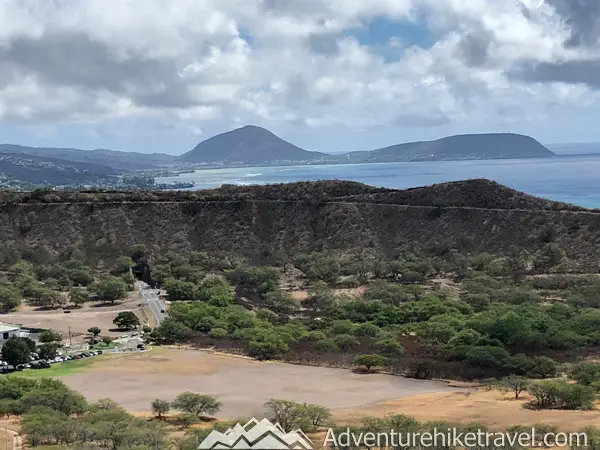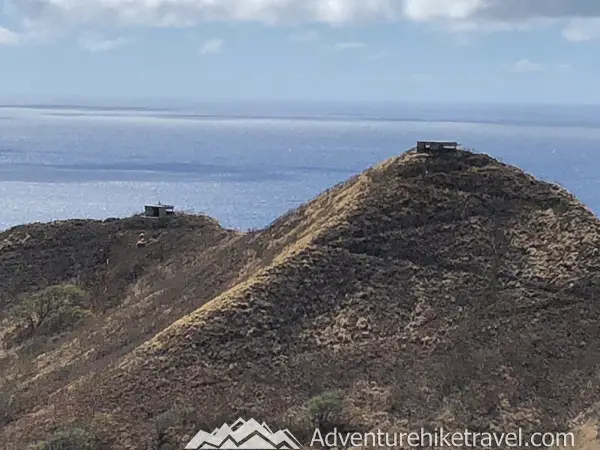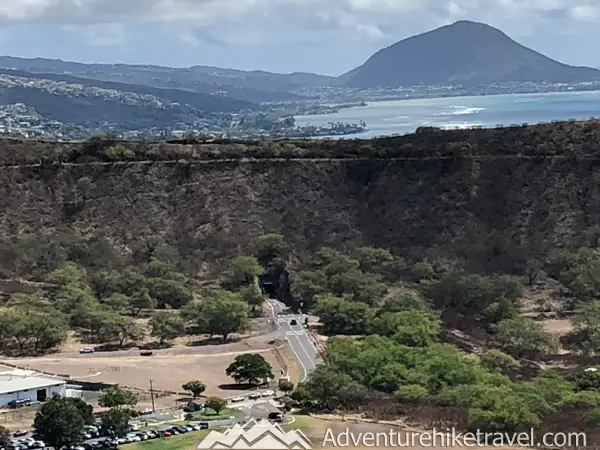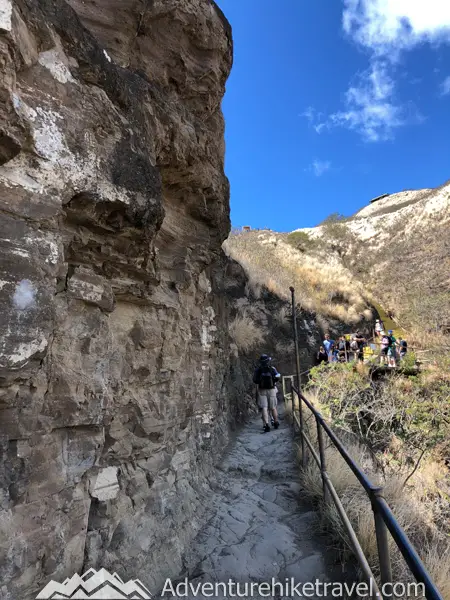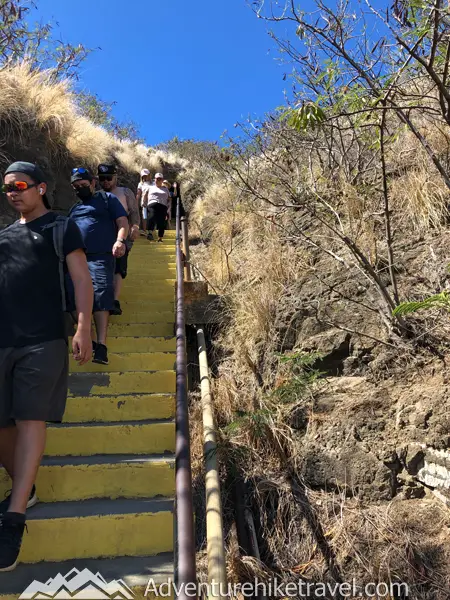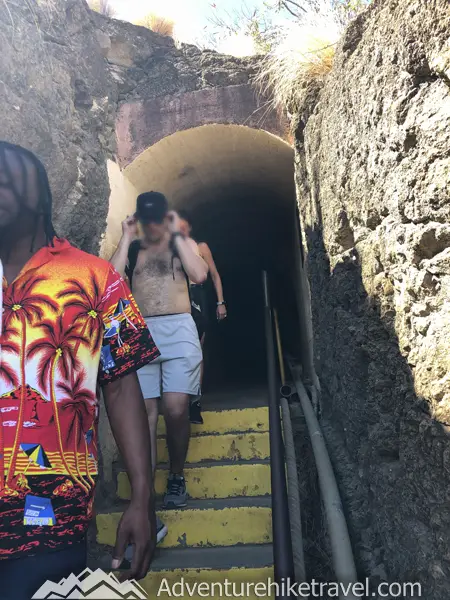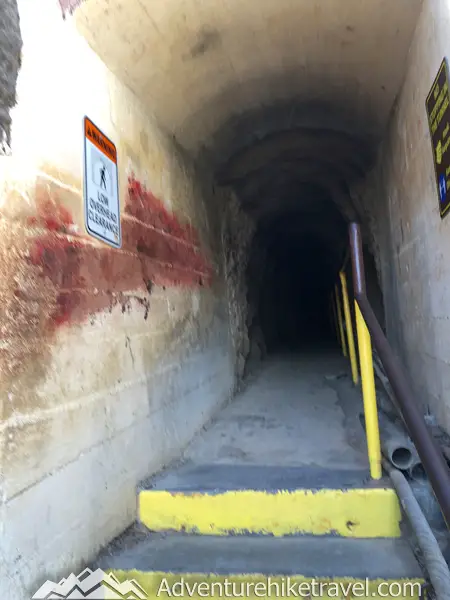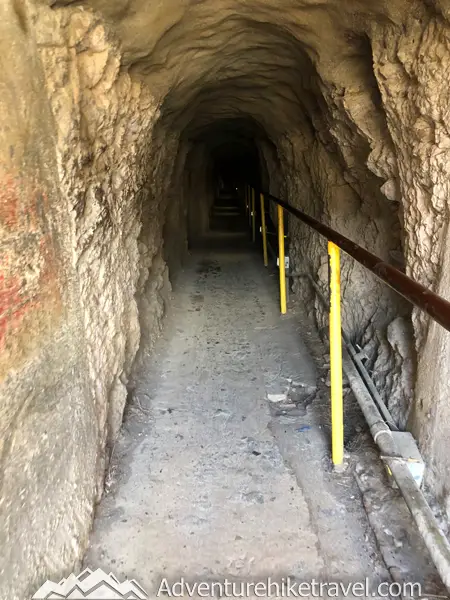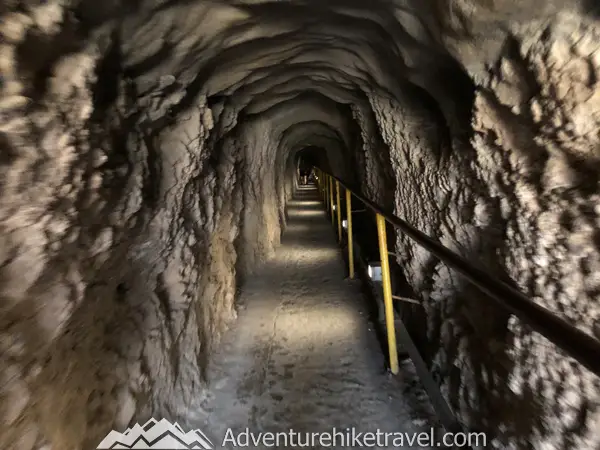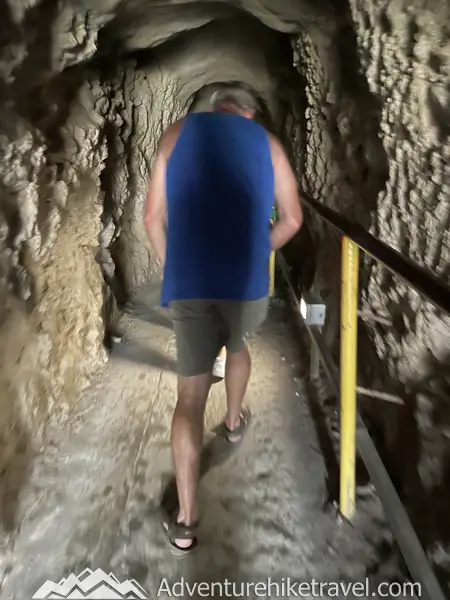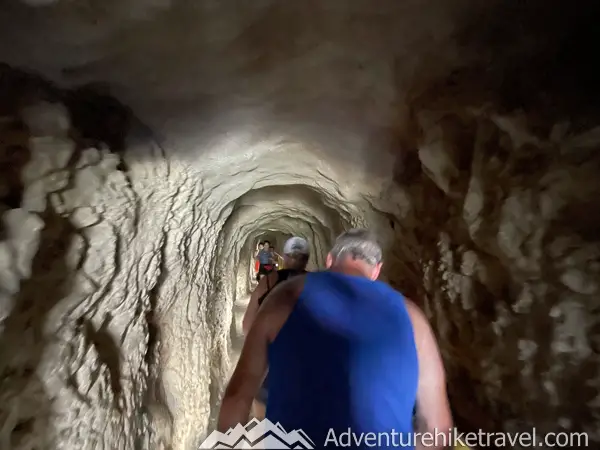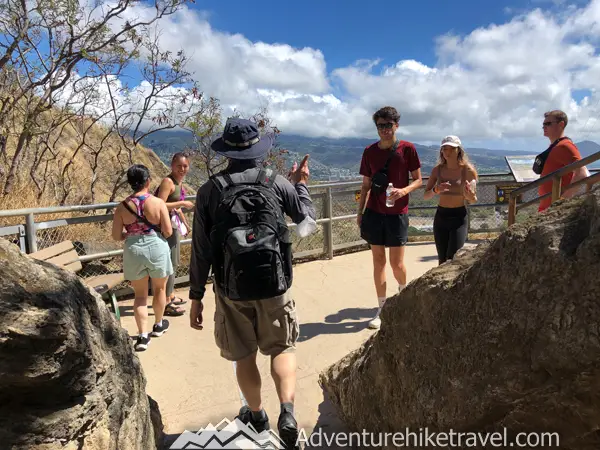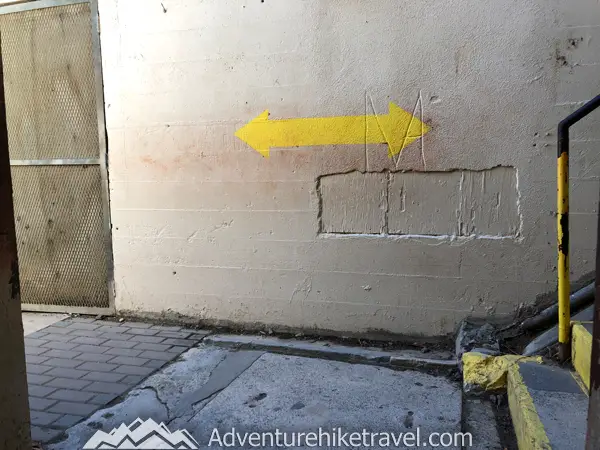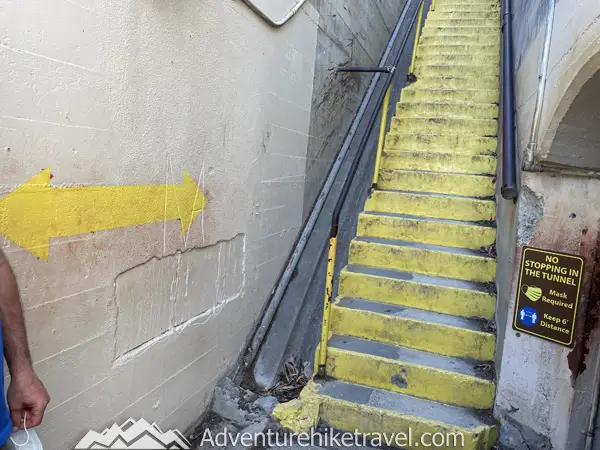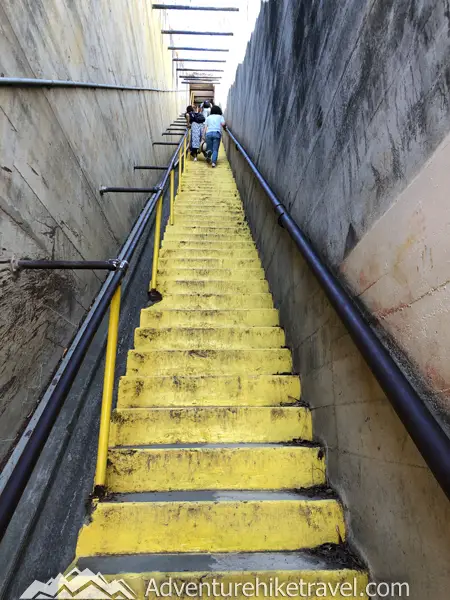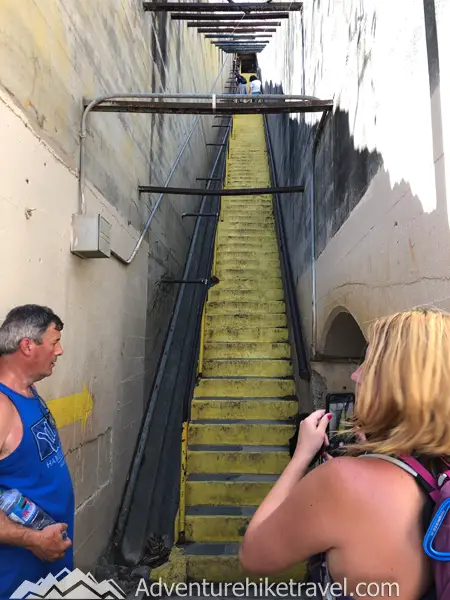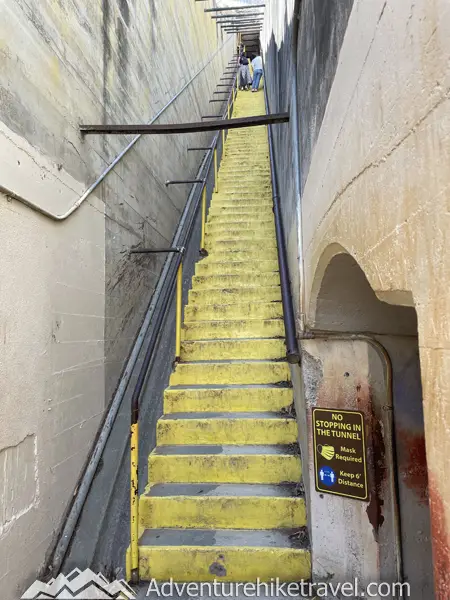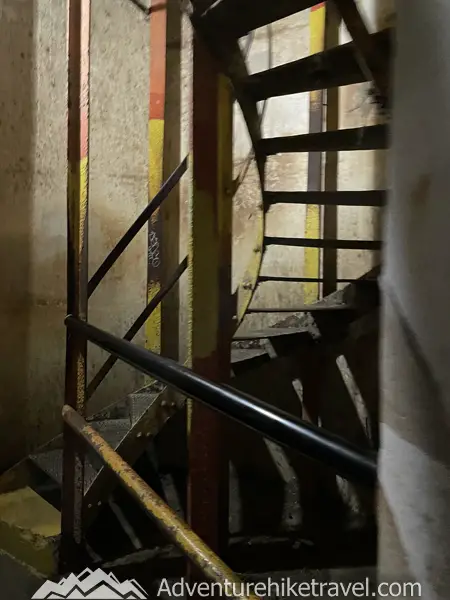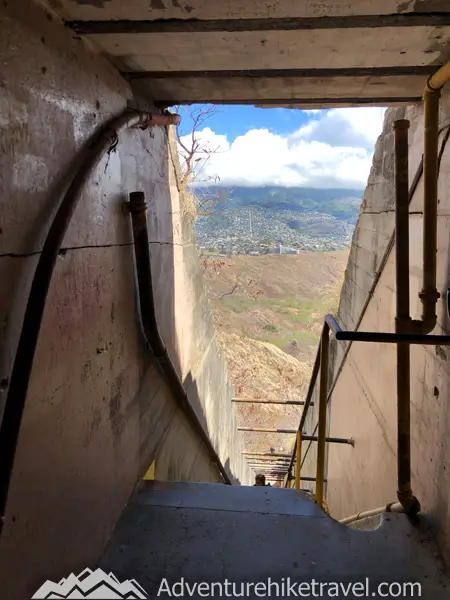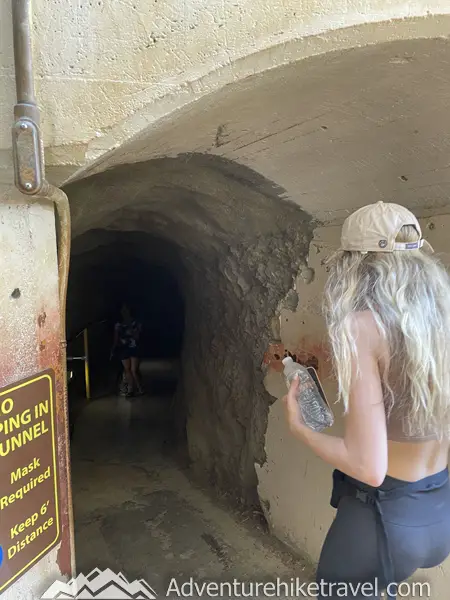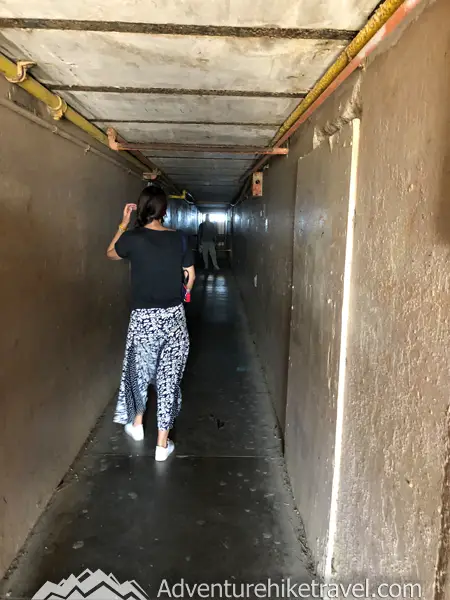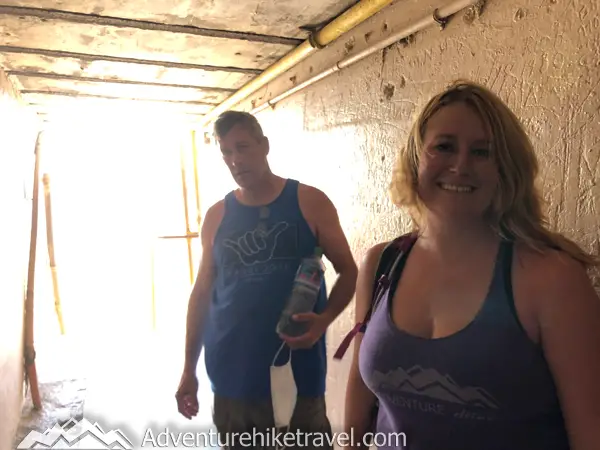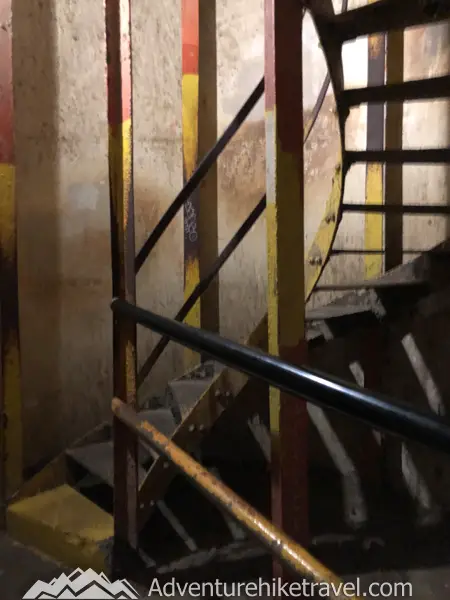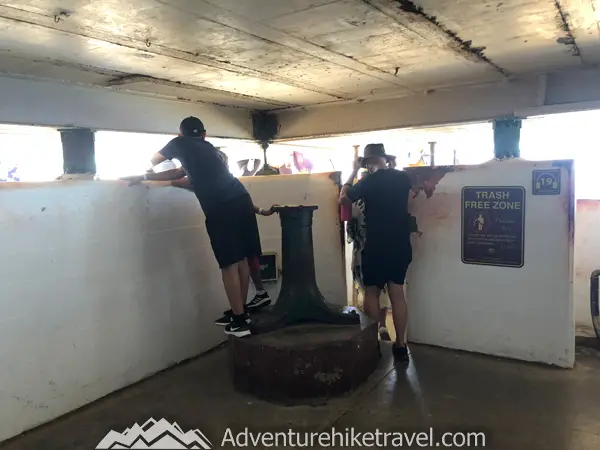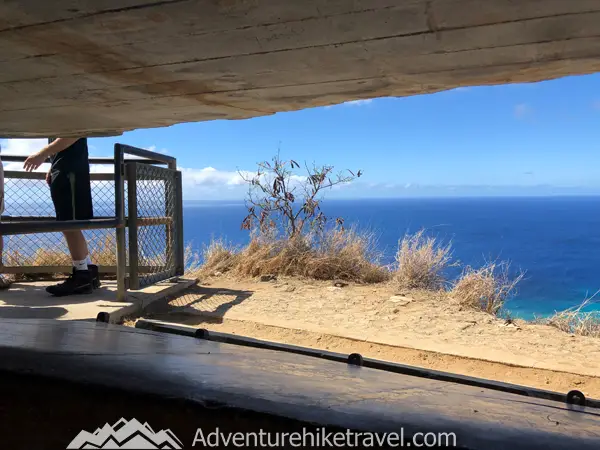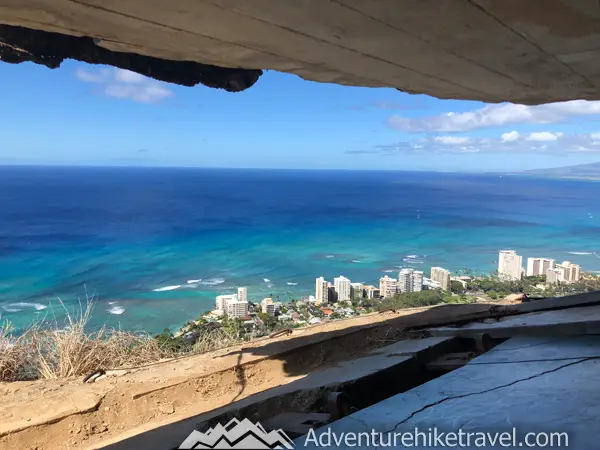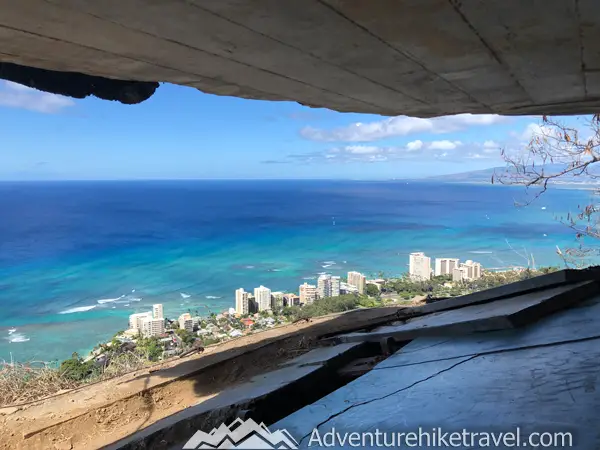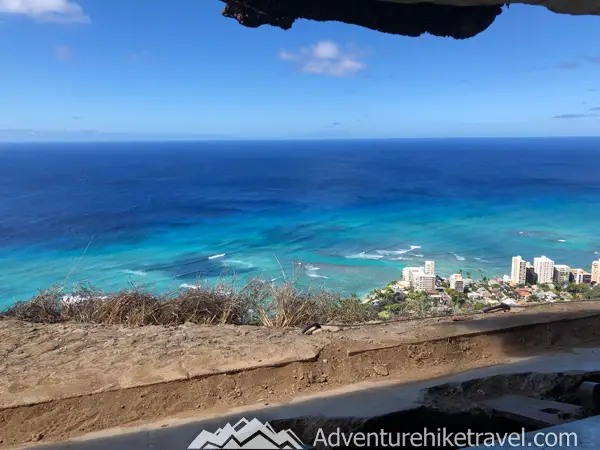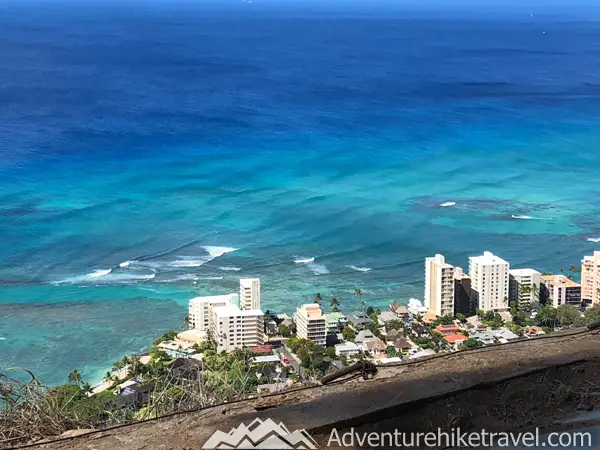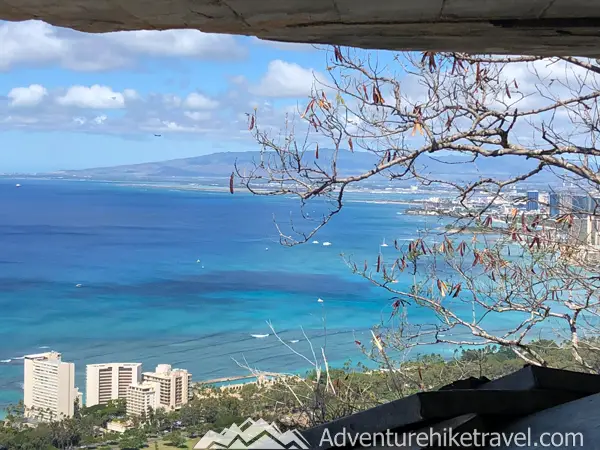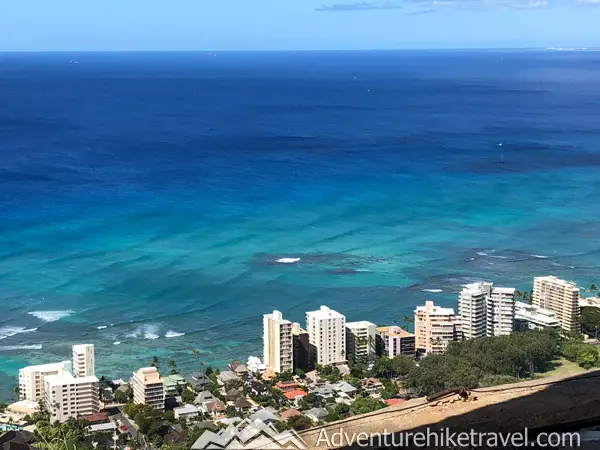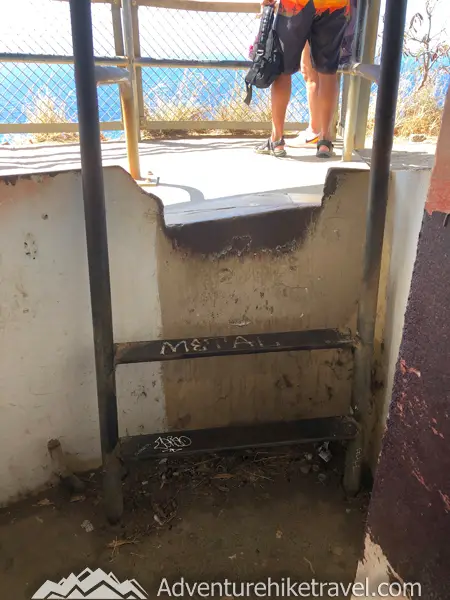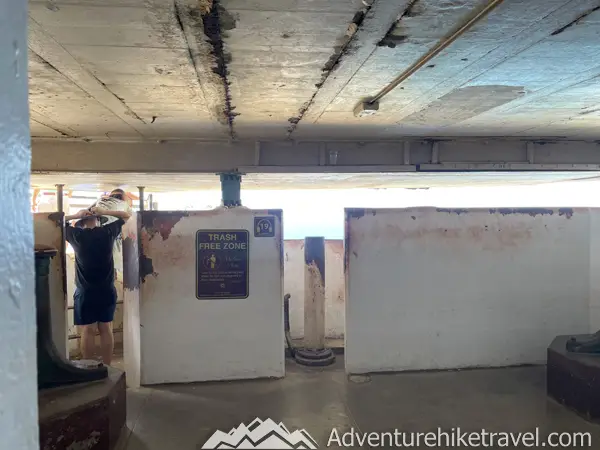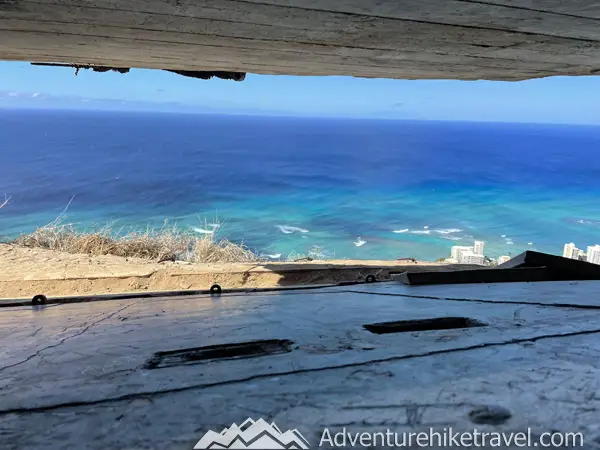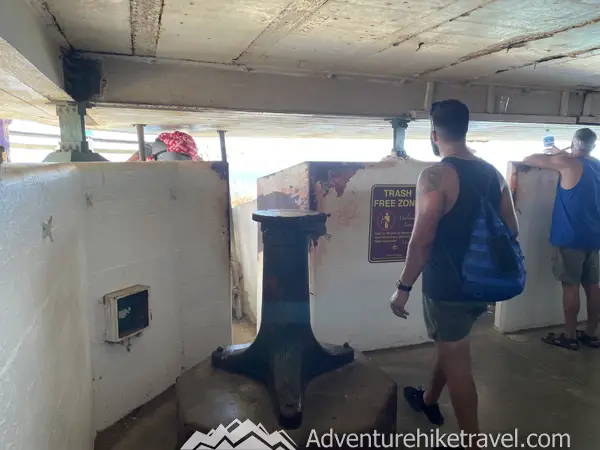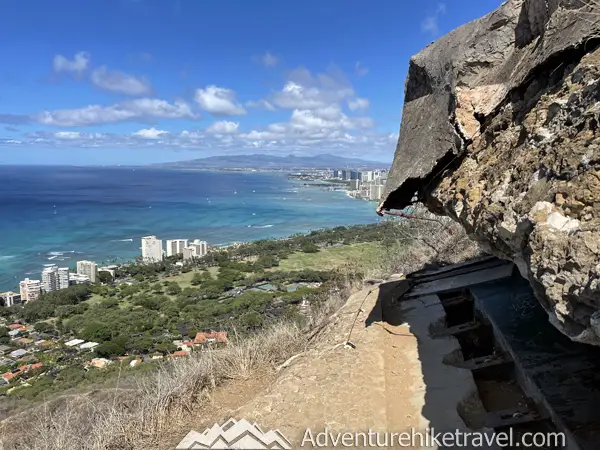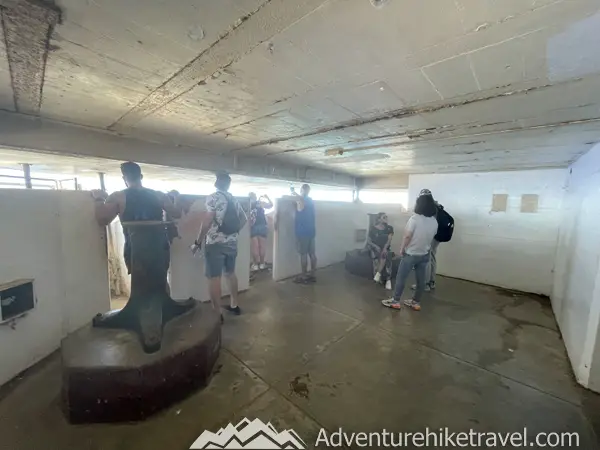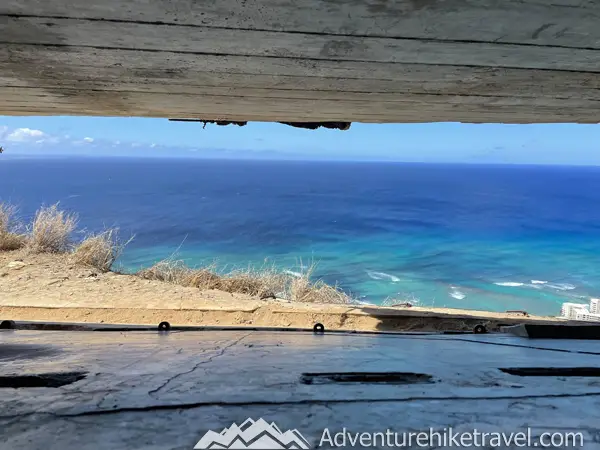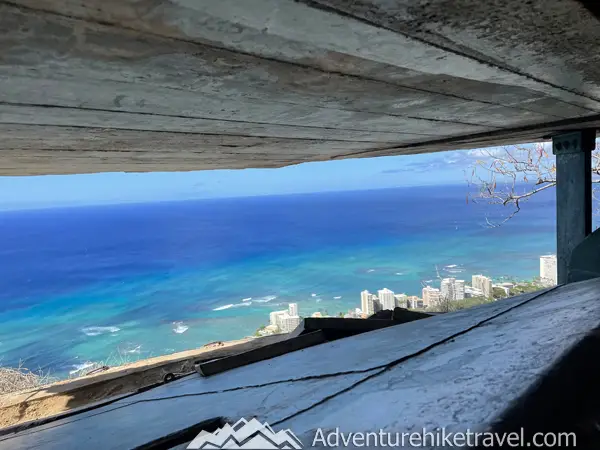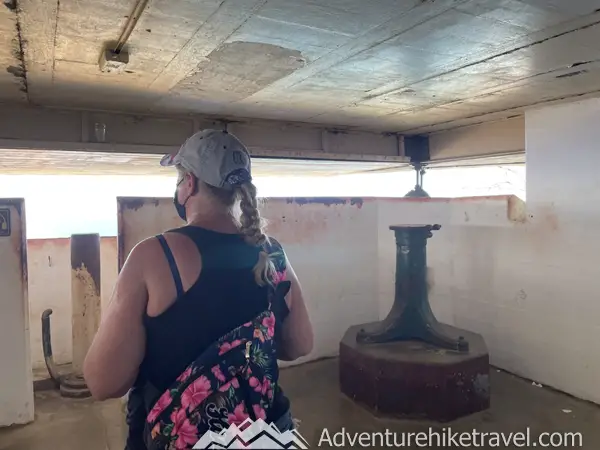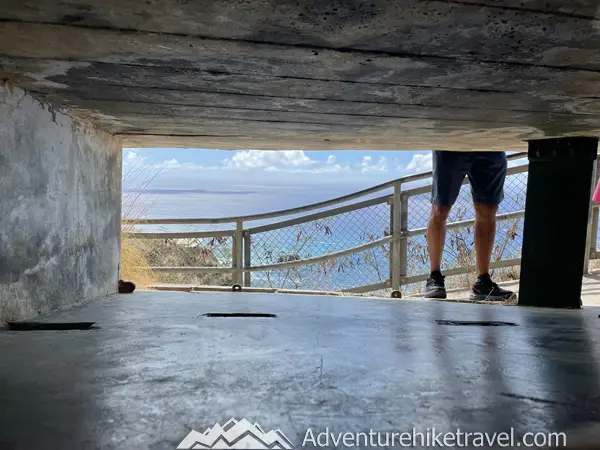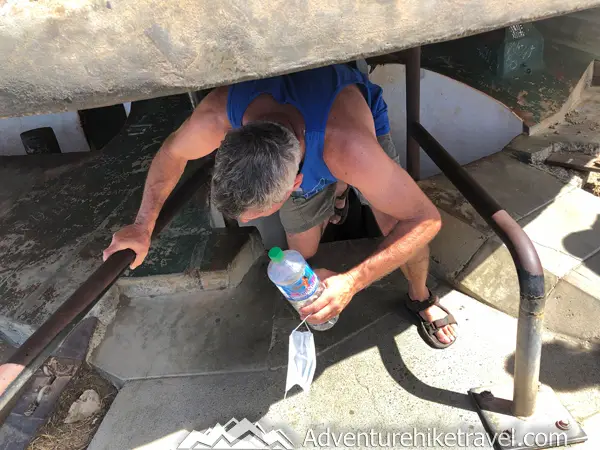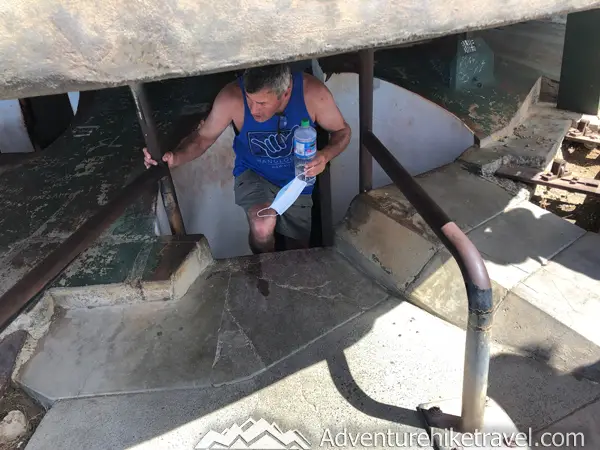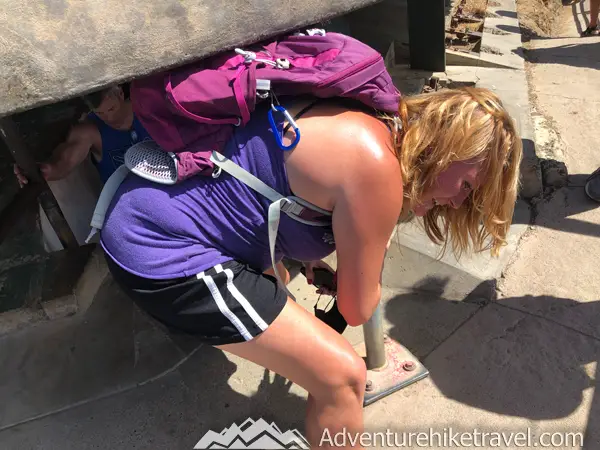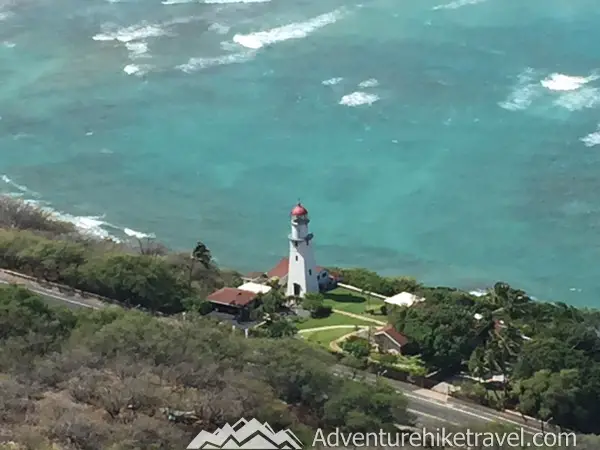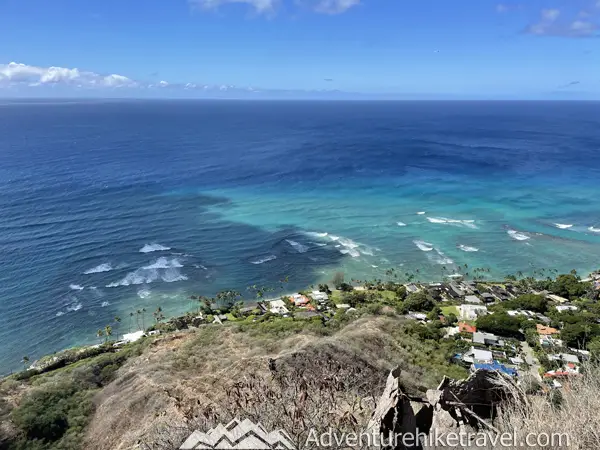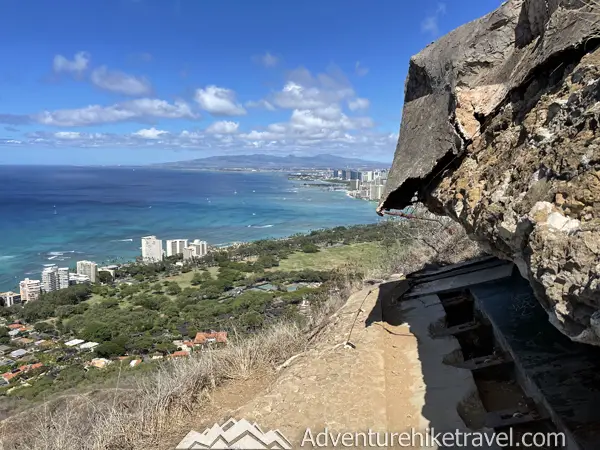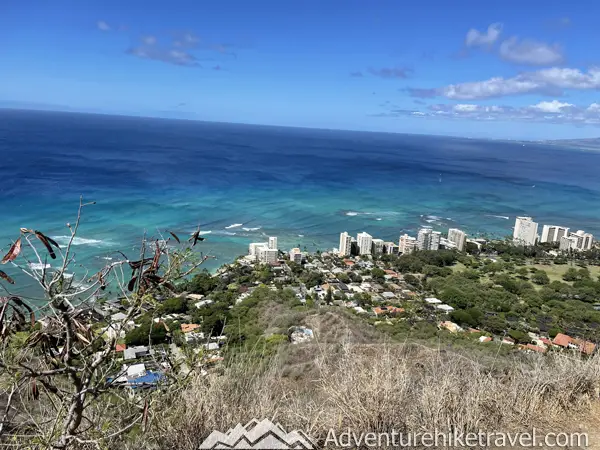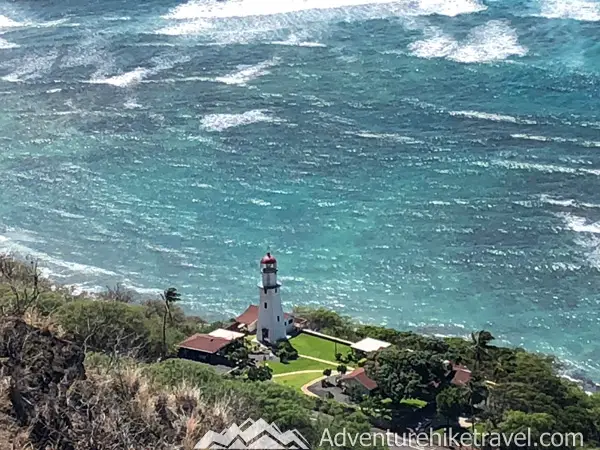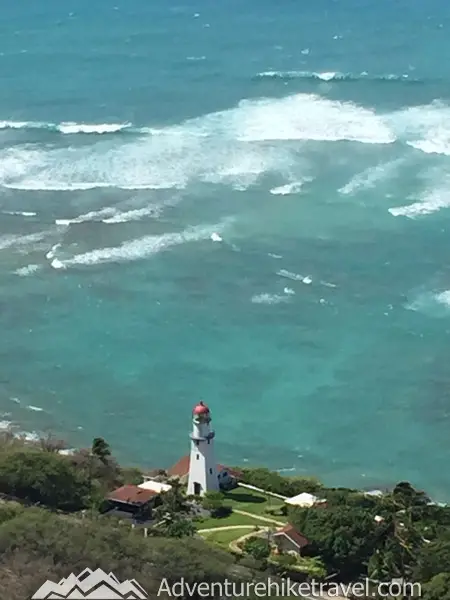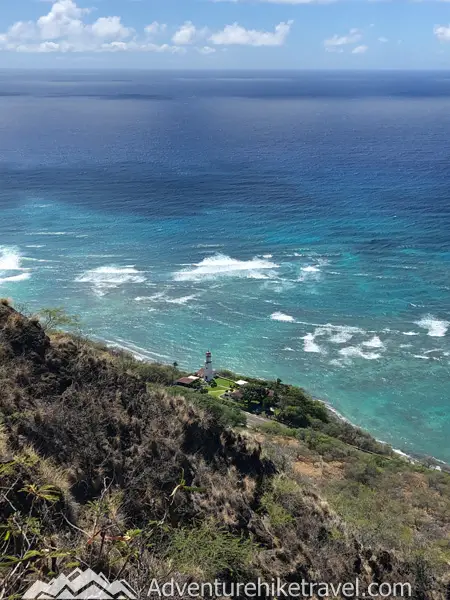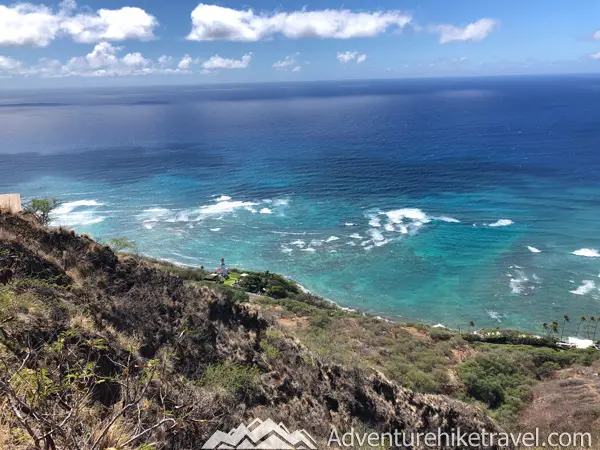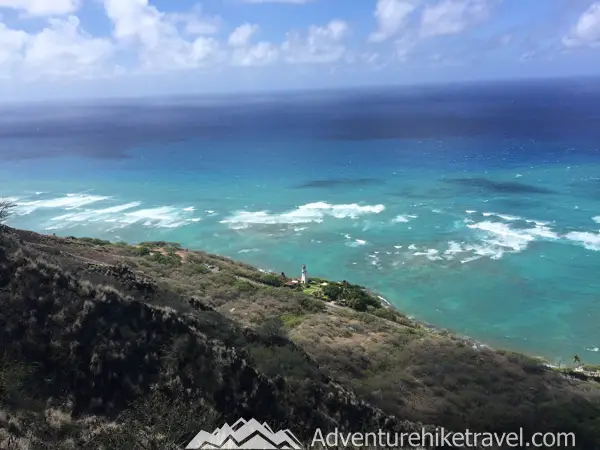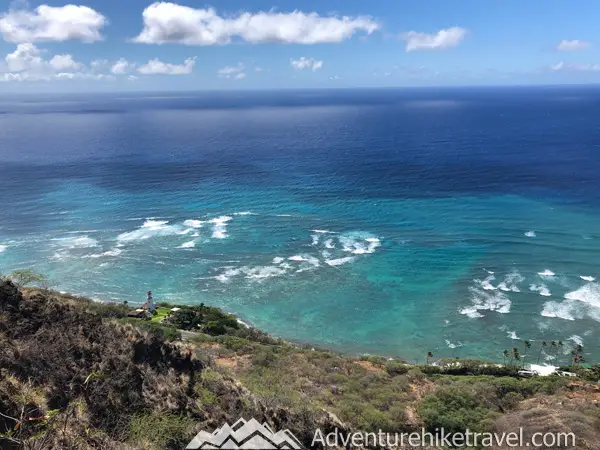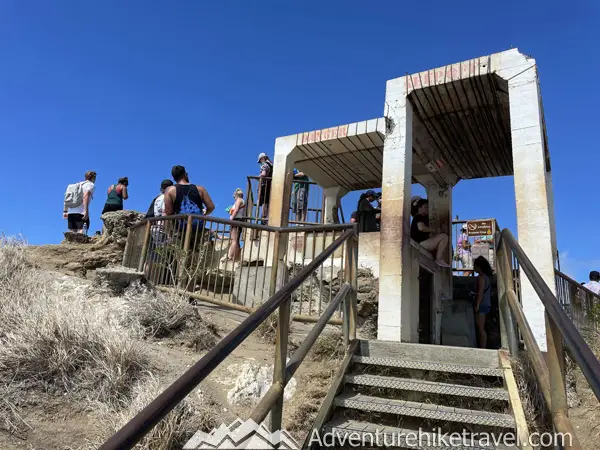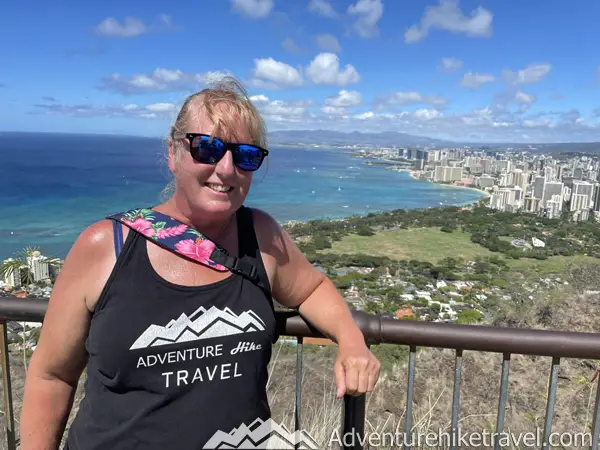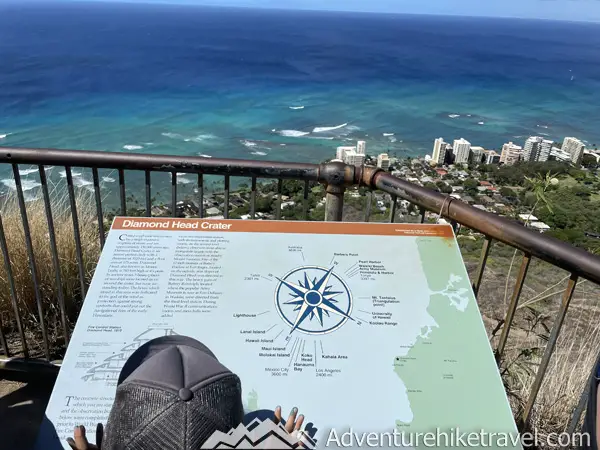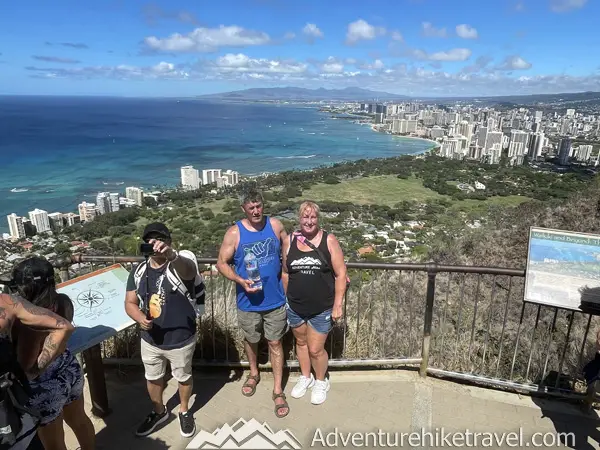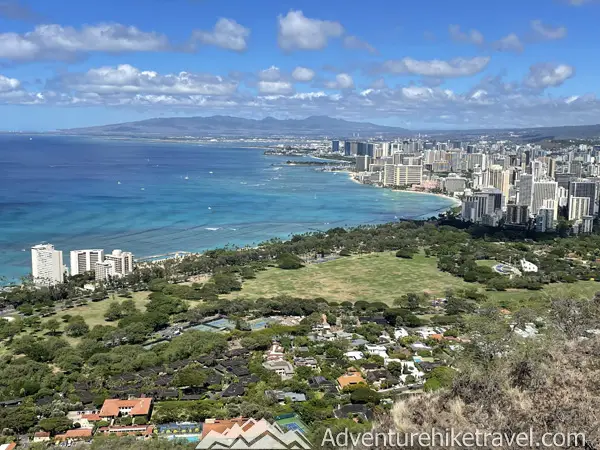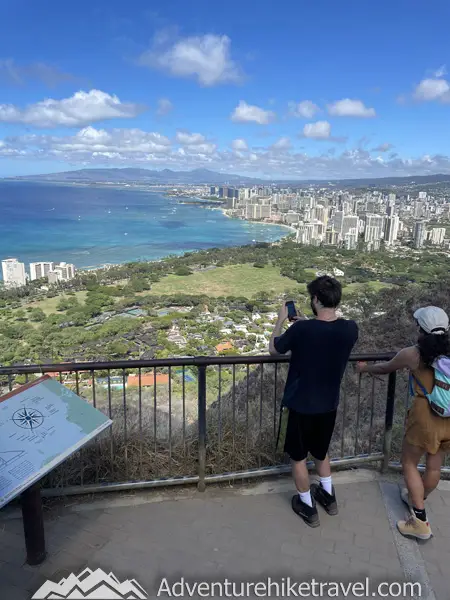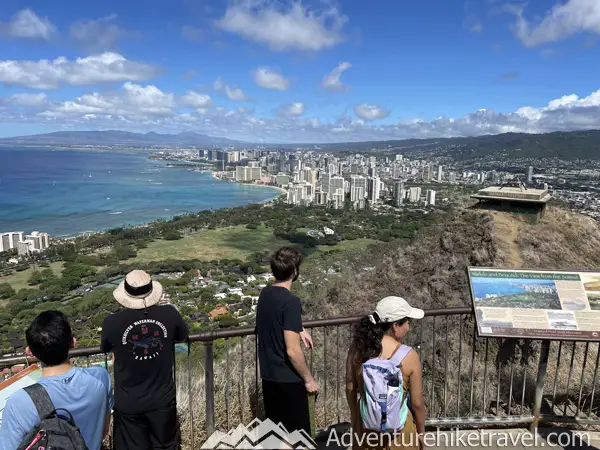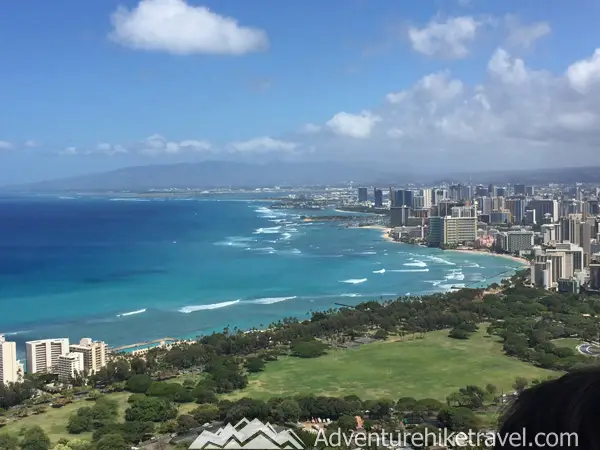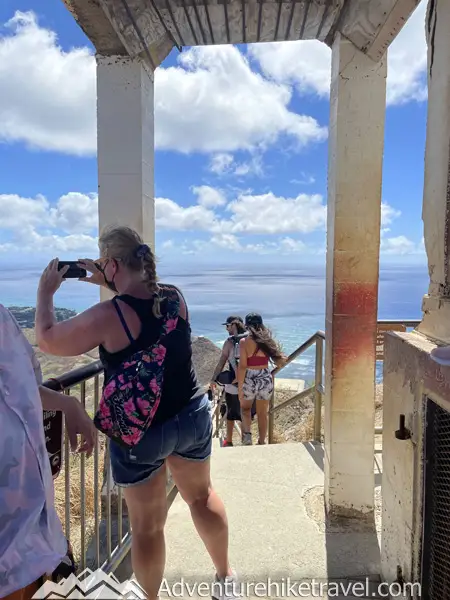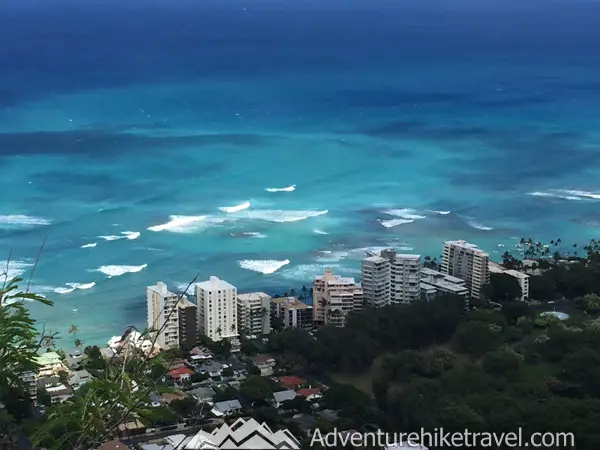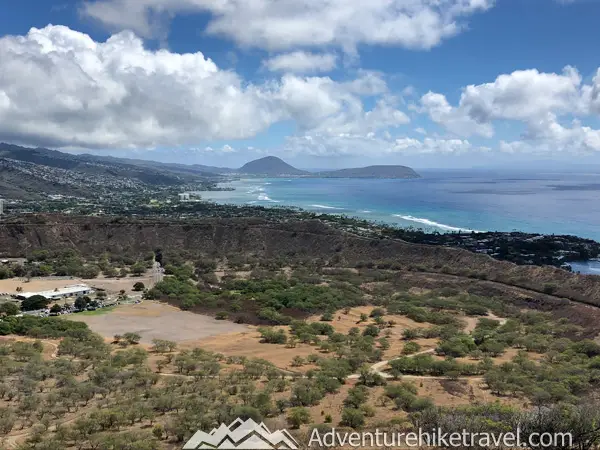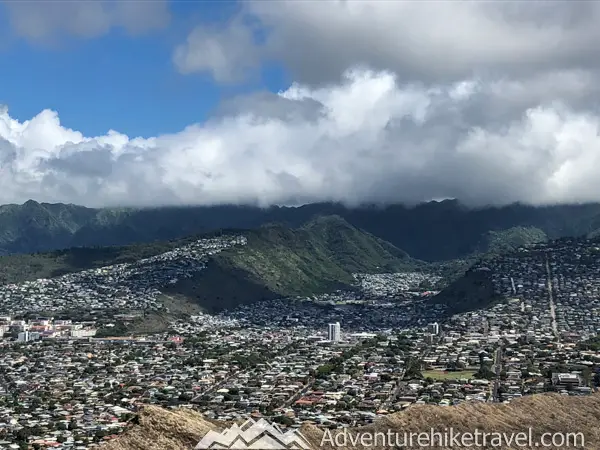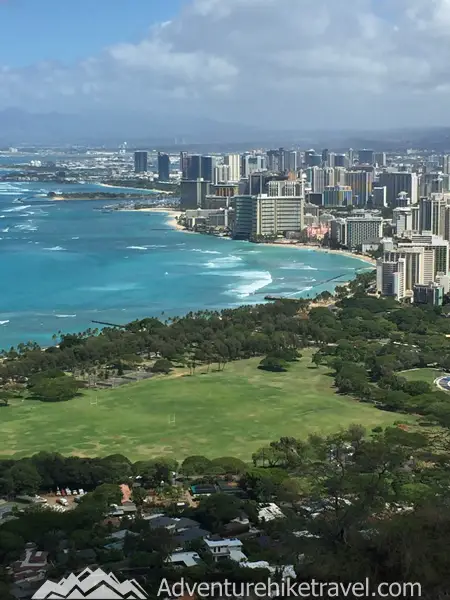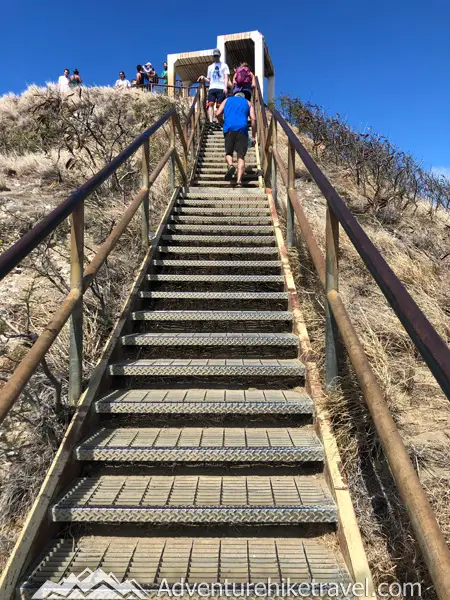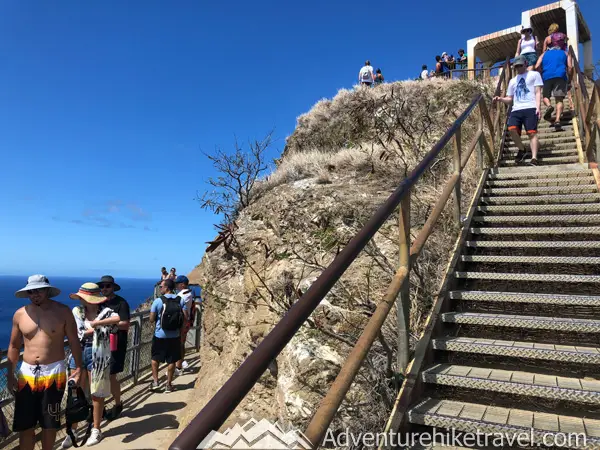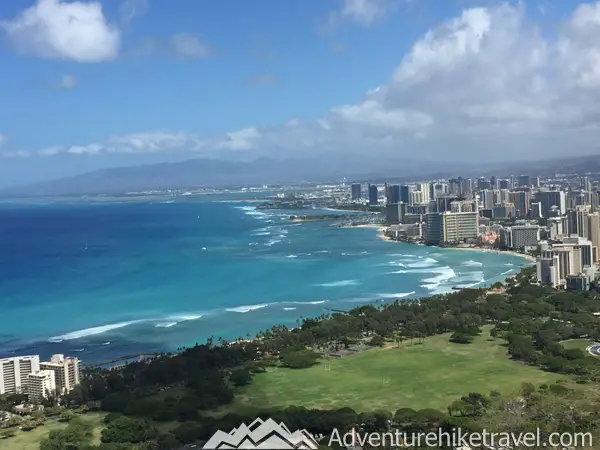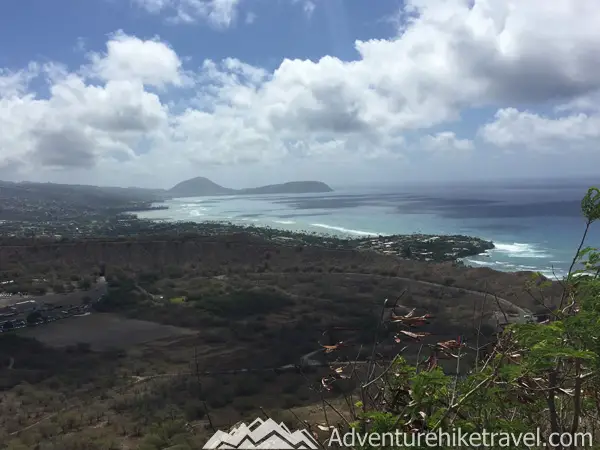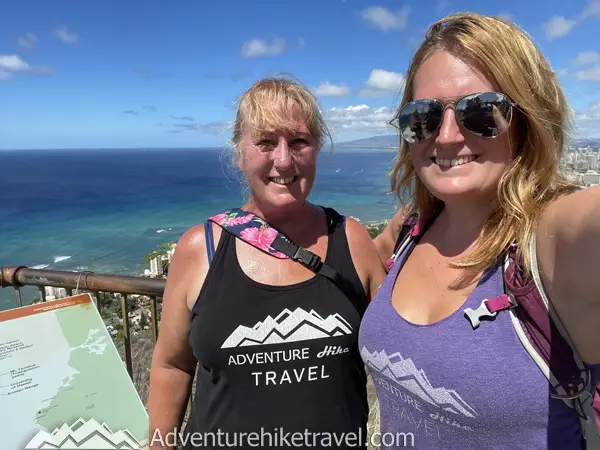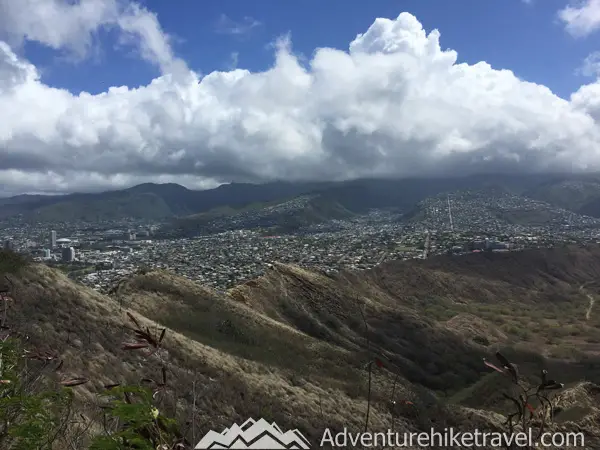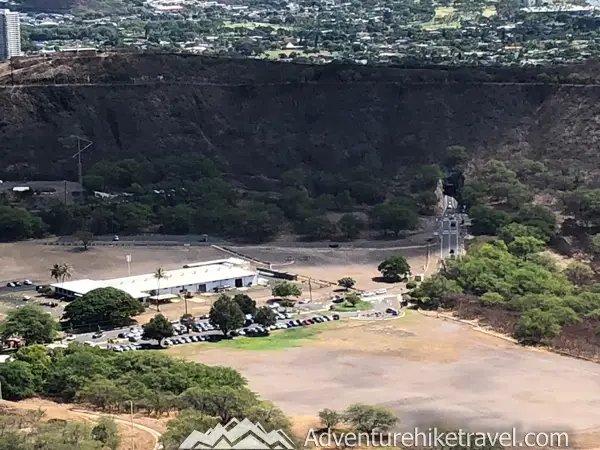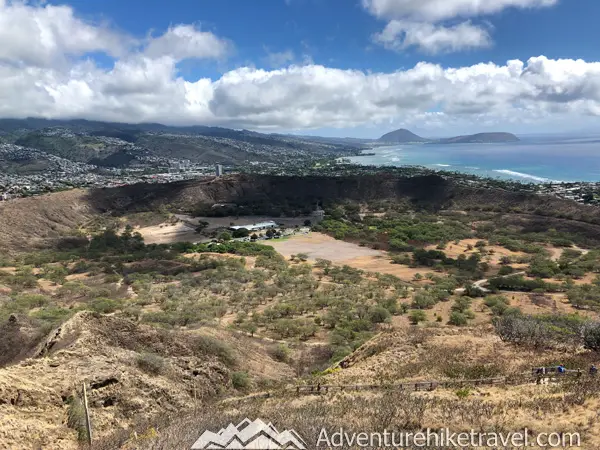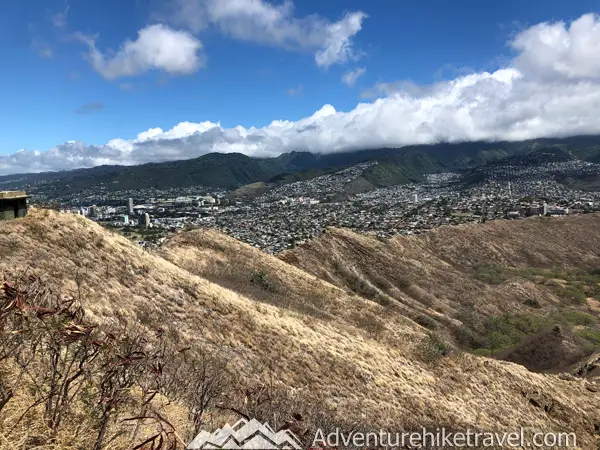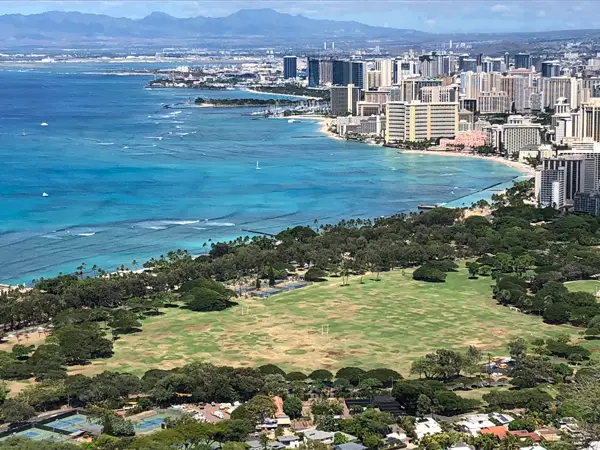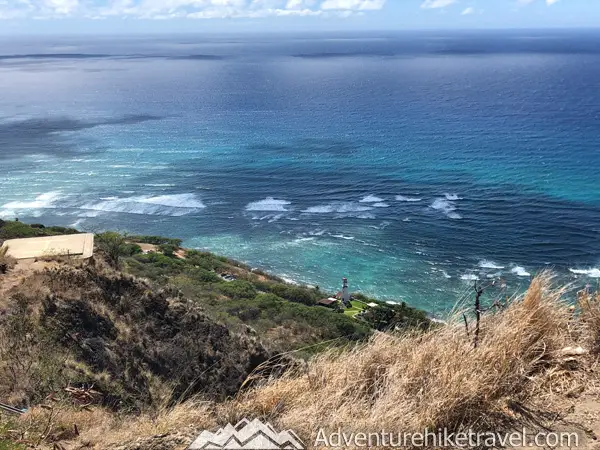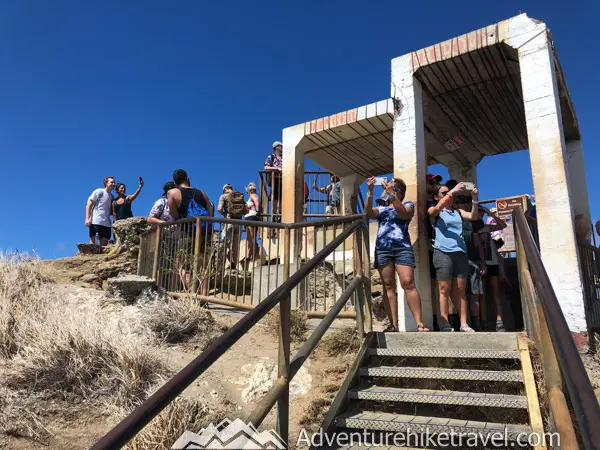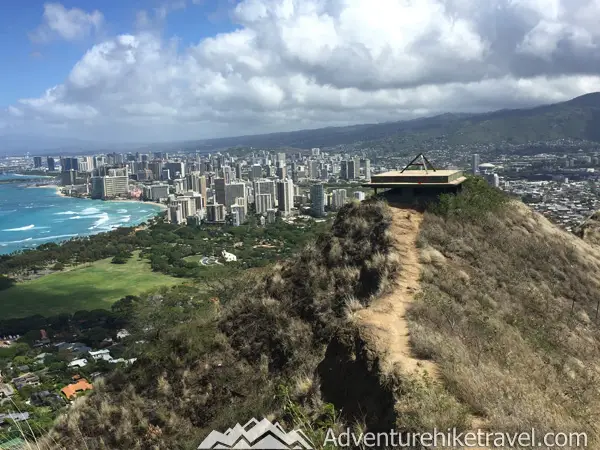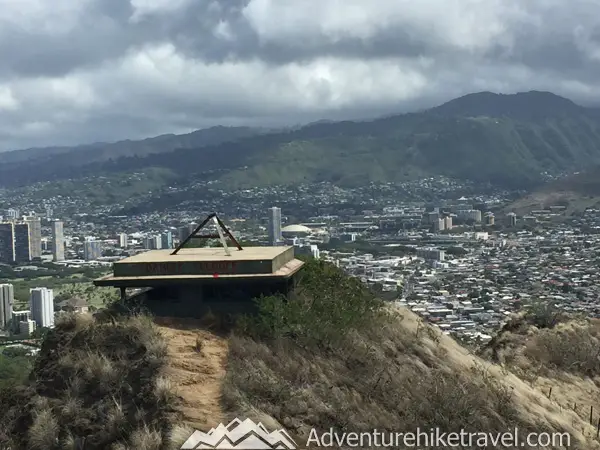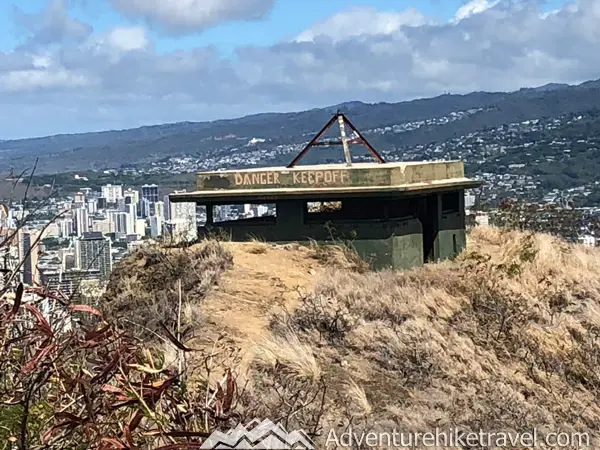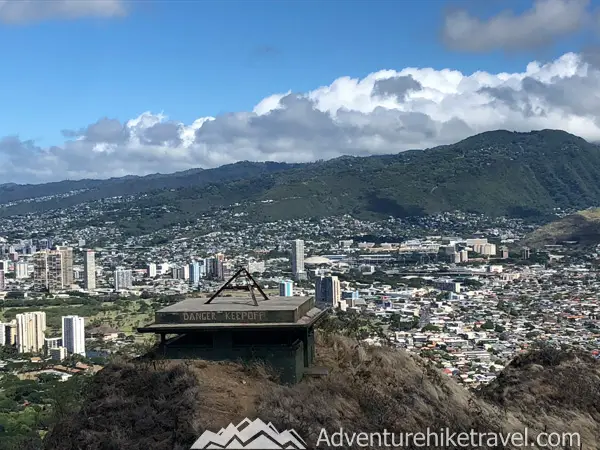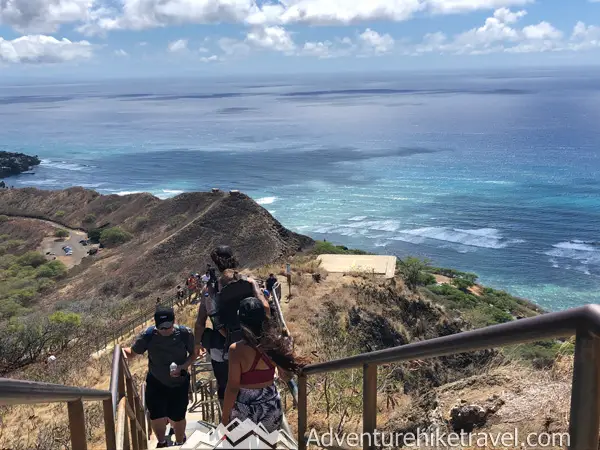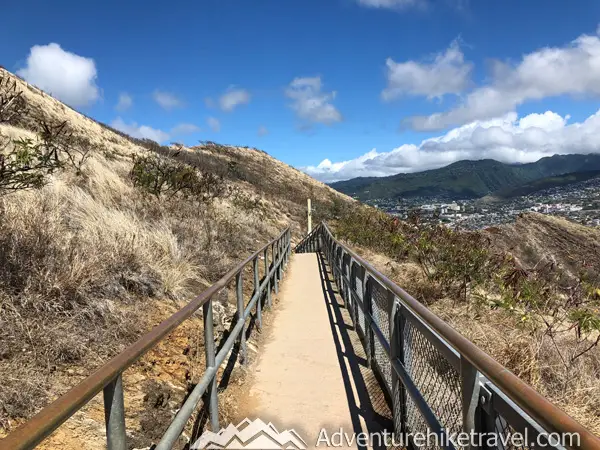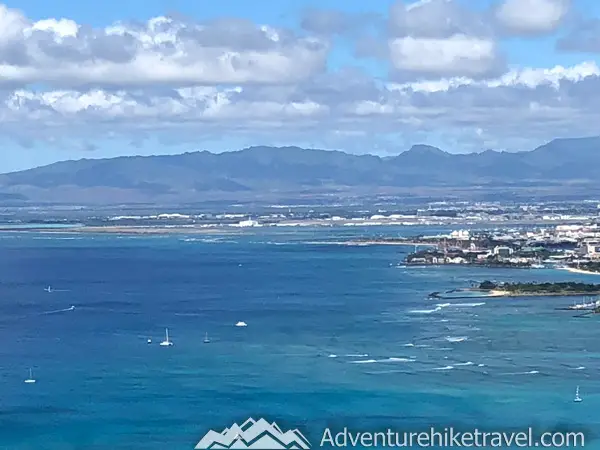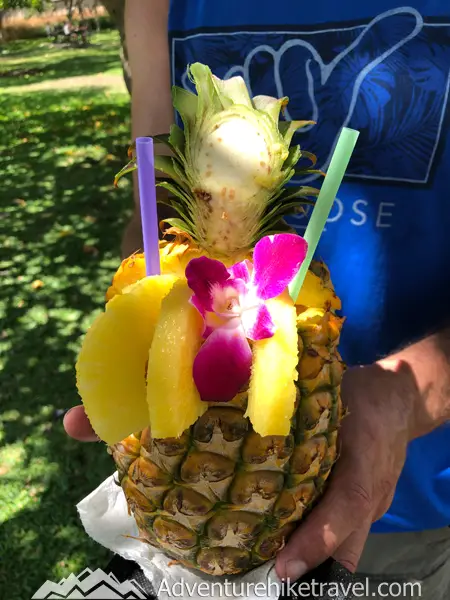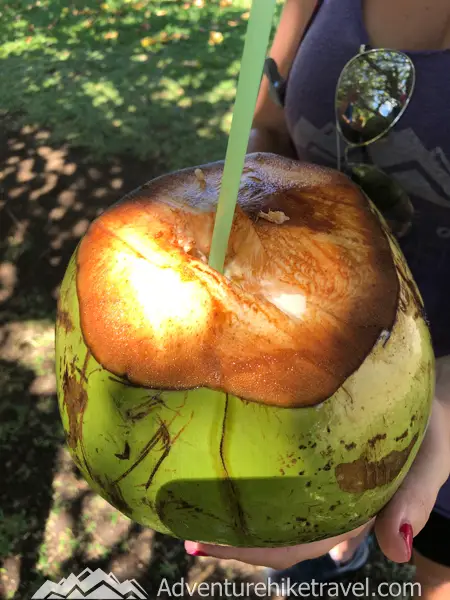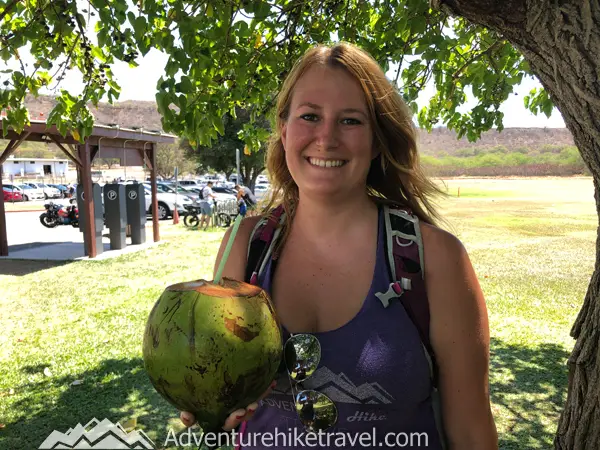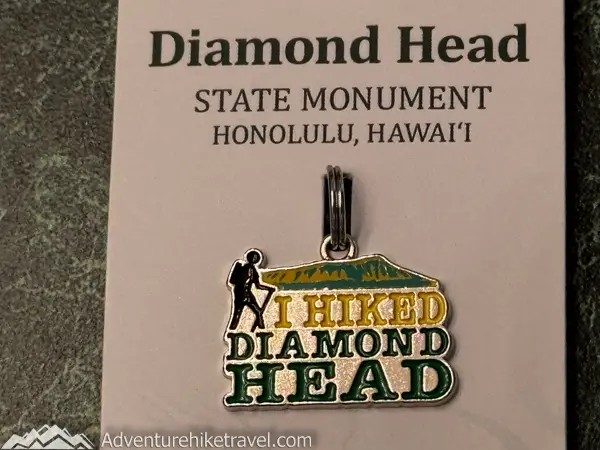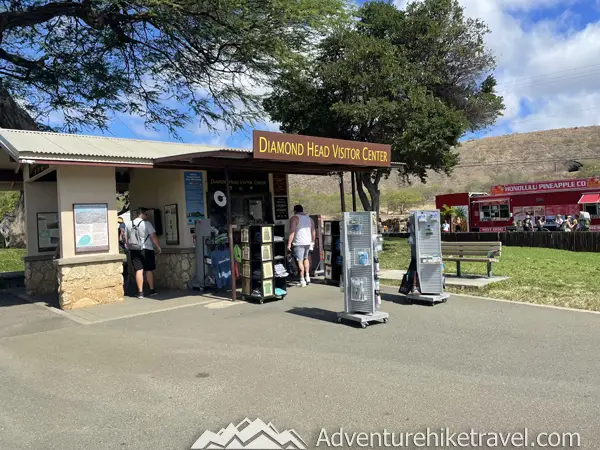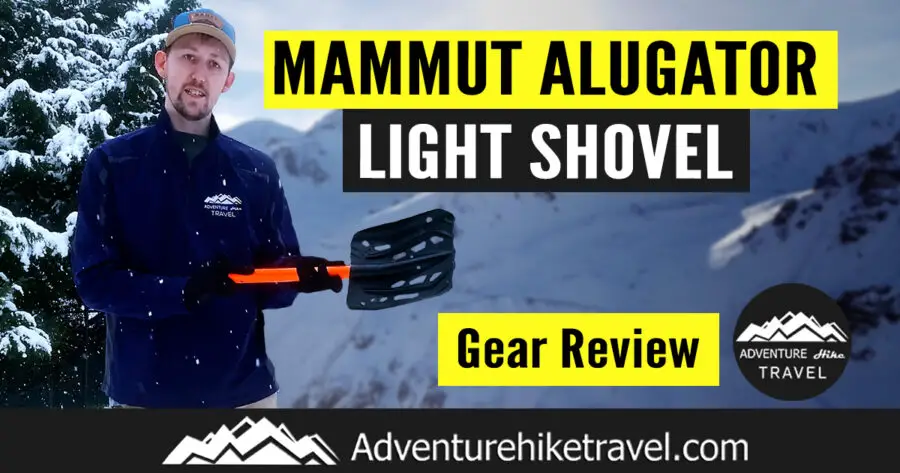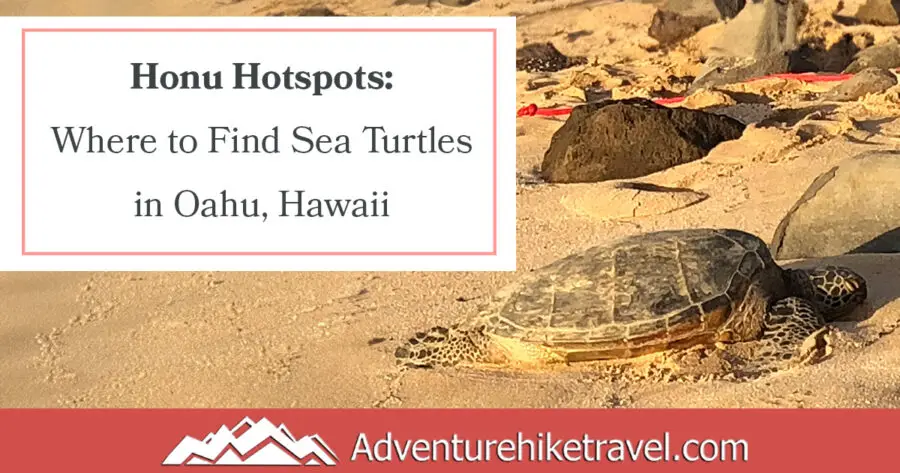Hiking the Diamond Head Summit Trail on Oahu, Hawaii
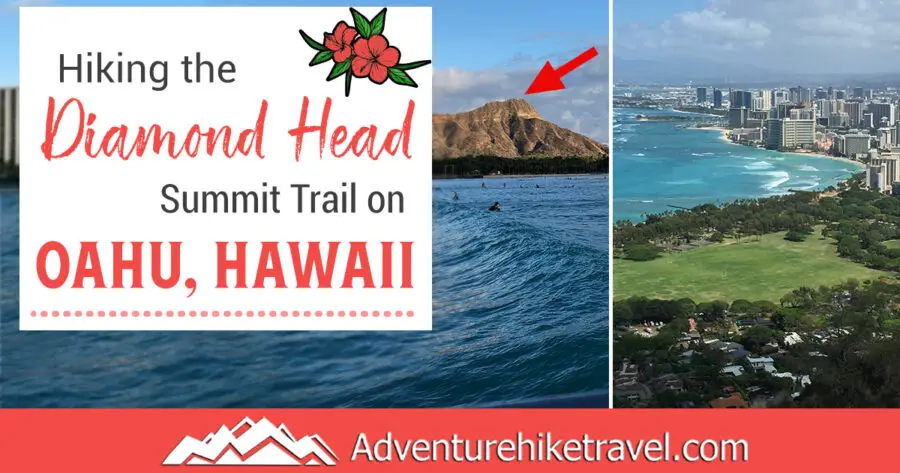
When visiting Oahu, Hawaii, one of the top ten things to do is to hike up to the summit of the Diamond Head (Lē‘ahi) Crater to see sweeping views of Waikiki and the surrounding sparkling blue coastline. The trail is 1.6 miles round trip, which can be completed in about 2 hours with a 560 ft. elevation gain. A historic military bunker, built in 1910, sits at the top and has an observation platform where you can take breathtaking pictures and see a navigational lighthouse below.
Trail Length: 1.6 miles (round trip)
Elevation Gain: 560 ft.
Time: 2 hours
Difficulty: Moderate
Unique Features: Summit a dormant volcano crater, 360º picturesque views of Waikiki and the surrounding coastline, climb through a historic military bunker with a spiral staircase.
Terrain: Hot, Dry, Slopes, Tunnels, and Staircases
The trailhead starts inside the crater at the Diamond Head State Monument, a beautiful park with picnic tables, restrooms, a small gift shop, and truck vendors selling fresh pineapple and coconut drinks.
https://dlnr.hawaii.gov/dsp/parks/oahu/diamond-head-state-monument/
While part of the trail is paved and flat, the hike is considered moderately challenging due to some rocky terrain, a 225’ dark narrow tunnel, an optional climb through the bunker, and steep sets of stairs. However, the trail is easy enough for whole families to enjoy, including children.
Toward the top, there are two ways to reach the summit. The easier trail to the left, with less steps, or the more challenging trail to the right with a steep staircase, then more spiral stairs up to the bunker. Our family opted to take the more challenging route, which left me a little winded, but let’s face it, going this way is just so much more fun!
A Little History
Diamond Head is a dormant volcano near the eastern edge of Waikiki’s coastline. The large 350-acre round-rimmed crater was formed from an eruption about 300,000 years ago. As the fine particles from the eruption settled, it hardened into a rock called ‘tuff.’ The calcite crystals in the ‘tuff cone’ exterior sparkled like diamonds, so sailors named it ‘Diamond Head.’ Native Hawaiians refer to it as Leahi (“brow of the ahi” yellowfin tuna.) Diamond Head is the most recognized landmark in Hawaii and was designated a National Natural Landmark in 1968.
Getting There
The entrance to the Diamond Head State Monument is off Diamond Head Road between Makapu’u Avenue and 18th Avenue, Honolulu. (Approximately a 12–20-minute drive from Waikiki.) The Kahala Tunnel (also called the Diamond Head Tunnel) through the outer rim of the crater brings you to the parking lot inside.
A fee is required for parking, so some Uber / Lyft drivers opt to drop you off outside the tunnel, leaving you to walk through on your own. However, there are numerous taxis available that come right through the tunnel entrance, or you can take your own vehicle or rental car, although parking is limited. There is also TheBus (Oahu’s public bus system), and the Waikiki Trolley.
The trailhead to the Summit Trail is adjacent to the Diamond Head Monument parking lot.
Hours
The Diamond Head Monument is open daily from 6:00 am to 6:00 pm.
The last entry into the park is at 4:00 pm and the gates are locked promptly at 6:00 pm by the Department of Defense, so all visitors must be out of the park by that time.
The park is closed Christmas and New Years.
Entrance & Parking Fees:
Entry fee: $ 5.00 per person
Parking: $10.00 per vehicle
- Credit Card only
- Hawaii Residents = Free entry and parking w/Hawaii ID or Driver’s License
- Children 3 and under = Free
Reservations
Non-residents need reservations for entry and parking (if needed), as of May 12th, 2022, which can be made up to 30 days in advance. Reserve early, because the park can get crowded and sell out.
Get Reservations Here:
You must arrive within the first 30 minutes of your reservation period, or you may be denied access, so DO NOT BE LATE! There will be no refunds for no-shows or late arrivals. The last reservation is at 4:00 pm.
If you reserve parking, you must exit the park by the end of your reservation period to allow room for those arriving in later timeslots. For visitors walking in or being dropped off, you may leave whenever you like.
Those without a reservation will be turned away.
Additional information regarding refunds and changes can be found on the website.
Other Considerations Before You Hike:
- Bring protective sunscreen, a hat, and sunglasses. Most of the trail is in full sun.
- Bring plenty of water. The trail is hot and dry. You may also want snacks.
- Wear good sneakers or hiking shoes. (Flip-flops and sandals are NOT recommended.)
- Check local surf and weather conditions. On occasion, the park may close due to inclement weather and rock falls.
- You may opt for the touristy official State of Hawaii Diamond Head State Monument Narrated Tour. Price: $7.99 (Reservations required.) The self-guided audio tour, available in various languages, includes a map and disposable earbuds, which you pick up at the visitor center. The audio tour gives great information on the history, legends, culture, geography, plant & animal life, music, and scenery of the trail as you hike.
- The Diamond Head Monument Visitor’s Center is open 7 days a week from 7 am to 2:30 pm. The last Audio Tour is at 2:30 pm and all audio devices must be returned no later than 3:30 pm.
Hiking the Diamond Head Summit Trail
Our family opted to take an Uber ride to the Diamond Head Monument parking lot. (Yes, our Uber driver took us through the tunnel and all the way in.) Then we went over to the Kiosk to pay our park entrance fee, although you must now make a reservation online prior to your visit.
Next, we walked up to the Diamond Head Visitor Center where you can view area maps and buy exclusive Diamond Head logo merchandise (not available anywhere else in Hawaii.) Use the restrooms before your hike because there are none along the trail. There are also water fountains to fill bottles. The park at the monument has many picnic tables, shaded by trees, where you can cool down either before or after the hike. (This was very nice after our hike in the hot sun!)
The path to the summit isn’t your typical outdoors trail for avid hikers but more a series of switchbacks, staircases, and tunnels making it a very interesting experience, even when crowded with other people. Over 1,000,000 visitors hike Diamond Head each year, making it Oahu’s 3rd largest visitor attraction.
The Diamond Head Summit Trail (to the left of the Visitor Center) starts off paved and very flat. Looks easy, doesn’t it?
Soon you will be able to see a distant glimpse of the two military bunkers (built in 1910) atop the ridge to your right. The bunker to the left marks the trail summit. The U.S. military used Diamond Head for their first line of defense in protecting Oahu’s southern shores during World War II. The trail was built in 1908 as part of O’ahu’s coastal defense system. Completed in 1911, the Fire Control Station at the summit directed artillery fire from batteries in Waikiki and Fort Ruger outside Diamond Head crater.
About a quarter mile into the hike, the trail changes to become an uneven rock path with rock cliff walls on your left. The terrain grows steeper, and the trail turns into a series of switchbacks. The views of the valley below come into view. Metal handrails line the trail to prevent you from falling over the edge.
If you purchased the audio tour at the visitor center prior to your hike, you can follow the numbered signs along the way to keep you on track with the narration.
The higher you climb, the more you can see the ridges in the crater walls. A concrete platform with metal rails allows you to step out and see the ocean water and the tunnel entrance on the opposite side of the crater.
After this, the trail narrows, the rock walls become steeper, and you come to the first staircase (76 steps), clearly marked with yellow paint. During the middle of the day, these can become crowded with two-way traffic as some people come back down. Take the staircase up to a dimly lit rock tunnel with a metal handrail. If you are afraid of the dark, you may want to bring along a small flashlight, but for most, it isn’t necessary.
At the end of this tunnel, you will see yellow arrows pointing to the left and right on the wall in front of you. The path to the left leads to a small seating area, then winds around with paved paths and shorter sets of stairs that will take you up to the Summit.
If you take the more challenging path to the right, you will climb a steep set of concrete stairs. How many stairs you may ask?
There are 99 stairs up through the center of the bunker!
It looks daunting, and you may be a little breathless when you reach the top, but coming up through the bunker is a unique experience that shouldn’t be missed!
Caution: These stairs are steep! My daughter brought along a metal water bottle which slipped from her hands and bounced several stairs downward. It almost took out a whole group of people below! Luckily no one was hurt. The water bottle now has a memorable dent.
These stairs lead to another tunnel, although this one looks man-made with smooth walls and pipes lining the ceiling.
When you emerge from the tunnel, you climb a spiral metal staircase to the inside of the bunker at the Diamond Head Summit. Through the window slots of the bunker, you get incredible panoramic views of the varying blue shades of ocean water below.
Two metal steps lead you out of the bunker but crouch down, so you do not hit your head. The ceiling of the bunker is very low, and you need to bend over to get out.
Views of the surrounding area are absolutely stunning, and you can see the historic Makapu'u Point Lighthouse (built in 1917) along the water’s edge below.
But wait! There’s more. Another set of stairs lead you up to the very top of the summit where there is a fantastic multi-level observation deck. The postcard views from the top prompt many people to take selfie photos in front of the Waikiki Beach backdrop.
There is a second bunker (inaccessible to the public) on the neighboring peak along the crater ridgeline.
It is only from the Diamond Head summit, with its 360-degree views, that you can see the entire rimmed circle of the crater, although the area is so vast I couldn’t fit it all in the picture. You can also see the beautiful shoreline of southeastern Oahu from Koko Head to Wai’anae. During the winter, you may even see some humpback whales passing by. It can be windy and cooler at the summit, so you might consider bringing a light jacket even if it is hot and humid below.
Once you have taken your fill of photos and enjoyed your time at the Diamond Head summit, you can start making your way back down by continuing the upper loop and taking the easier trail lined with handrails to the right. This brings you down a set of grated metal stairs, paved pathways, and leads back to the tunnel. From there, you hike down the same path you came up.
When you return to the Diamond Head Monument, you may be hungry for food, ice cream, or want a refreshing drink, all available from the Honolulu Pineapple trailer. We got a cold pineapple smoothie, which was the best I have ever had! Much better than others I’d had on the island. At that moment, after a hot hike, that pineapple smoothie was pure heaven! We also bought a coconut water drink, which was also good, but the pineapple smoothie was the favorite!
At the souvenir stand, I also bought a collectible charm saying ‘I hiked the Diamond Head Summit Trail’ to stick onto my day pack.
While other hikes in Hawaii may be more lush and less populated, this trail is beautiful and unique, offering different obstacles to navigate as you make your way the way to the top.
Definitely worth the visit!
Additional Things to Know:
Best Time to Visit Oahu: Mid-April to early June and between September to mid-December.
Diamond Head State Monument Safety Video
Facilities at Diamond Head Monument
- Food concession
- Picnic Pavilion
- Picnic tables
- Restrooms
- Trash cans
- Water fountain
- Gift shop
- Scenic Viewpoint
- The park facilities on the crater floor of the Diamond Head Monument are fully accessible to those with disabilities. However, the hiking trail to the summit is not ADA accessible, as there is uneven, rocky terrain and steep staircases.
Prohibited
- No animals or pets
- No bicycles
- No open fires
- No smoking
- No alcoholic beverages
- No rock climbing or camping
- No commercial activities
Park Online Store:
https://pacifichistoricparksbookstore.org/collections/diamond-head
Audio Tour:
https://fareharbor.com/embeds/book/phptours/items/30629/calendar/2024/06/?flow=1425&full-items=yes
Park Brochure:
To view or download, see the link for the park brochure on the main site.
https://dlnr.hawaii.gov/dsp/parks/oahu/diamond-head-state-monument/

Guest Blogger: Darlene Panzera
Darlene Panzera is a multi-published author of sweet, fun-loving contemporary and historical romance. She has also written a children’s book series with her daughter, Samantha, based on their horses, and enjoys camping, hiking, and all kinds of adventure and travel in the great outdoors. www.darlenepanzera.com
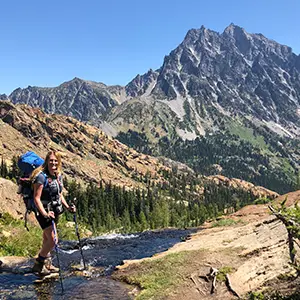
Want To Fill Your Life With Adventure?
Join our newsletter for an adrenaline-fueled journey! Receive exclusive updates on travel tips, gear reviews, epic hikes, captivating stories, and inspiration to turn your dreams into reality.
Don't just dream it, live it! Get Out There!

Other Blog Posts You May Like
Driving Around O’ahu: 7 Best Stops In 1 Day
Lake 22: Great Early Season Hiking In Washington State
Hiking to Maiden Peak from Deer Park in Olympic National Park
Tolmie Peak Fire Tower Trail in Mount Rainier National Park
The Ultimate Guide to Backpacking to Lake Angeles in Olympic National Park
Hiking After ACL Surgery: Tips And Tricks For A Safe And Successful Return
The Ultimate Guide to Backpacking Lake Ingalls and Headlight Basin in Washington State
12 Years of Hiking with Meindl Boots: The Ultimate Review
Snowshoeing the Scenic Skyline Lake Trail in Washington State
High Rock Lookout – Hiking in Gifford Pinchot National Forest
High Rock Lookout Photo Gallery
Backpacking Upper Lena Lake – Olympic National Park
Milk Lake: Beautiful Hidden Gem in Olympic National Park
How to Successfully Do A Sunrise Hike Up Mt. Townsend
The Ultimate Guide To Hiking Mailbox Peak
Marymere Falls – Easy Hike in Olympic National Park
Franklin Falls Easy Beautiful Winter Hike Near Seattle
Narada Falls (Paradise Mt. Rainier Hikes)




















